Sony Group MV65ST DVD Player With FM Transmitter User Manual MZ 65ST
Sony Corporation DVD Player With FM Transmitter MZ 65ST
User Manual
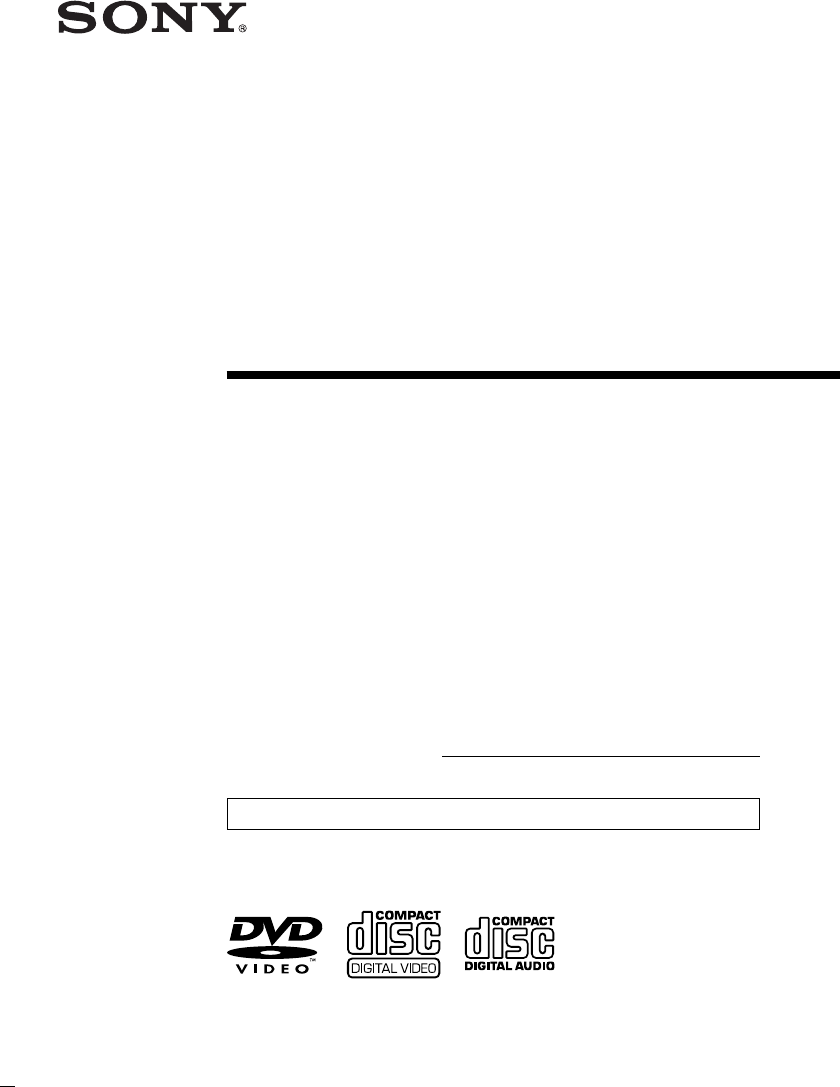
© 2004 Sony Corporation
MV-65ST
For installation and connections, refer to “Connection” on page 8.
Owner’s Record
The model and serial numbers are located on the bottom of the unit.
Record these numbers in the space provided below.
Refer to these numbers whenever you call upon your Sony dealer regarding this
product.
Model No. MV-65ST Serial No.
2-021-315-11 (1)
Operating Instructions
Portable DVD
Player
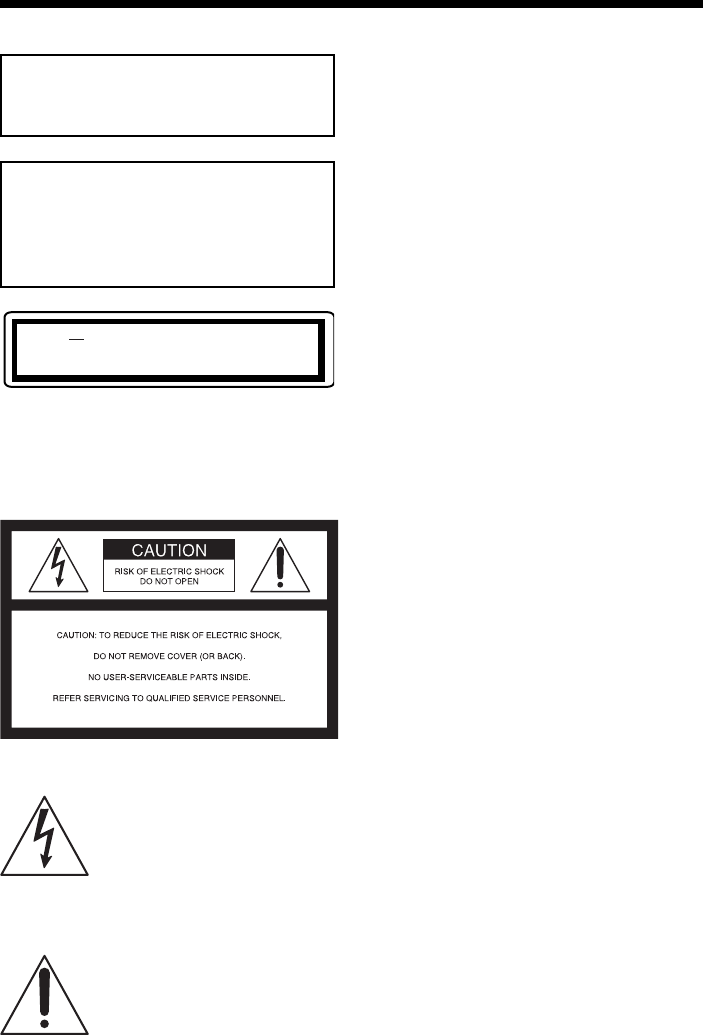
2
DANGER INVISIBLE
AVOID DIRECT EXPOSURE TO BEAM.
LASER RADIATION WHEN OPEN.
CAUTION
The use of optical instruments with this
product will increase eye hazard.
CAUTION
Use of controls or adjustments or
performance of procedures other than
those specified herein may result in
hazardous radiation exposure.
This is located on the drive unit's internal
chassis.
To prevent fire or shock hazard, do not
expose the unit to rain or moisture.
This symbol is intended to
alert the user to the presence of
uninsulated “dangerous
voltage” within the product’s
enclosure that may be of
sufficient magnitude to
constitute a risk of electric
shock to persons.
This symbol is intended to
alert the user to the presence of
important operating and
maintenance (servicing)
instructions in the literature
accompanying the appliance.
Warning
Warning
This equipment has been tested and found to
comply with the limits for a Class B digital
device, pursuant to Part 15 of the FCC Rules.
These limits are designed to provide
reasonable protection against harmful
interference in a residential installation. This
equipment generates, uses, and can radiate
radio frequency energy and, if not installed
and used in accordance with the instructions,
may cause harmful interference to radio
communications. However, there is no
guarantee that interference will not occur in a
particular installation. If this equipment does
cause harmful interference to radio or
television reception, which can be determined
by turning the equipment off and on, the user
is encouraged to try to correct the interference
by one or more of the following measures:
— Reorient or relocate the receiving
antenna.
— Increase the separation between the
equipment and receiver.
— Connect the equipment into an outlet on
a circuit different from that to which the
receiver is connected.
— Consult the dealer or an experienced
radio/TV technician for help.
You are cautioned that any changes or
modifications not expressly approved in this
manual could void your authority to operate
this equipment.
CAUTION
The use of optical instruments with this
product will increase eye hazard.
For the customers in the United
States
This product contains mercury. Disposal of
this product may be regulated if sold in the
United States. For disposal or recycling
information, please contact your local
authorities or the Electronics Industries
Alliance (http://www.eiae.org).

3
Table of Contents
Welcome ! .............................................................. 4
Precautions ............................................................ 4
About this manual ............................................... 5
About discs this player can play ........................ 6
Connection ............................................................ 8
Resetting the player ........................................... 10
Location of controls ........................................... 11
Various Playback
Playing a disc ...................................................... 13
Searching a chapter/title/track directly .......... 14
Resume playback .................................................15
Using MP3/JPG menu ........................................15
Displaying elapsed time ................................... 16
Changing the subtitle language ....................... 17
Using a DVD menu ............................................ 18
Using the TOP MENU button ............................18
Using the MENU button .....................................18
Changing the audio language .......................... 19
Changing angles ................................................. 19
Changing the audio output .............................. 20
Using the PBC (playback control) function .... 20
Changing Setup
System settings — SYSTEM menu .................. 21
Selecting the language on the menus
— OSD LANGUAGE..................................... 21
Setting the screen saver
— SCREEN SAVER ........................................22
Returning this player to the factory setting
— LOAD SETUP DEF.................................... 22
Settings for DVD playback
— DVD SETUP menu .................................. 22
Selecting the audio language for DVD
— AUDIO .......................................................22
Displaying the subtitles for DVD
— SUBTITLE ................................................... 23
Setting the aspect ratio for the TV screen
— TV SCREEN ...............................................23
Displaying the multi-angle notice
— ANGLE MARK .......................................... 23
Preparing for the initial parental setting
— PARENTAL CONTROL .......................... 23
Setting the password — PASS WORD .............. 24
Selecting the speaker mode
— SPEAKER menu ....................................... 25
Selecting the downmix mode
— DOWNMIX ................................................25
Selecting the digital audio output mode
— AUDIO menu ........................................... 25
Selecting the color system for the output
video signal — VIDEO menu ..................... 26
Monitoring video signals input from the
connected device ........................................... 26
Selecting the color system for the input
video signal.................................................... 27
Settings by using the MENU button on the
monitor ........................................................... 27
Adjusting the contrast .........................................27
Adjusting the brightness ..................................... 28
Adjusting the color ..............................................28
Adjusting the hue (NTSC only) ......................... 28
Adjusting the dimmer .........................................28
Resetting the adjustments................................... 28
Setting the screen mode ...................................... 28
Setting the FM transmitter .................................. 29
Setting the blue background screen .................. 29
Exiting the menu operation ................................ 29
Turning the image upside down...................... 30
Setting the reference volume ............................ 30
Additional information
Maintenance........................................................ 31
Notes on discs ..................................................... 32
About MP3 files .................................................. 33
Specifications ...................................................... 34
Troubleshooting.................................................. 35
Error display ....................................................... 36
Language Code List ........................................... 37
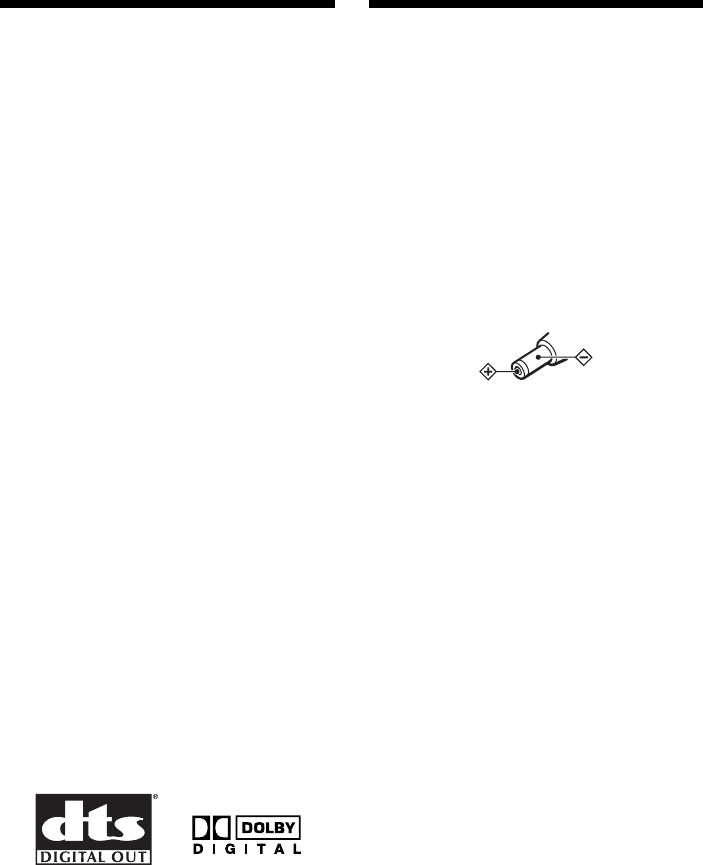
4
Precautions
To avoid the risk of serious injury or accident,
read the following precautions before
installing and operating the player.
On safety
Do not put any foreign objects in the DC IN
12V jack.
On power sources
•Use house current or car battery (12 V DC).
•For use in your house, use the AC power
adaptor supplied with the player. Do not use
any other AC power adaptor since it may
cause the player to malfunction.
•Connect the AC power adaptor to an easily
accessible AC outlet. Should you notice an
abnormality in the AC power adaptor,
disconnect it from the AC outlet
immediately.
•The player is not disconnected from the AC
power source (mains) as long as it is
connected to the wall outlet, even if the
player itself has been turned off.
•If you are not going to use the player for a
long time, be sure to disconnect the power
supply (AC power adapter or car battery
cord). To remove the AC power adaptor from
the wall outlet, grasp the plug itself; never
pull the cord.
On heat build-up
Heat may build up in the player if it is used for
an extended period of time. This, however, is
not an malfunction.
For driver's safety
Comply with your local traffic rules and
regulations.
•While driving
— The driver must not watch or operate the
player. It may lead to distraction and
cause an accident.
— The driver must not use the headphones.
It may lead to distraction and cause an
accident.
Park the car in a safe place when the
driver watch and operate the player or use
the headphones.
Thank you for purchasing this Sony Portable
DVD Player. You can enjoy its various features
even more with:
•DVD/Video CD/Audio CD playback.
•Support DTS/Dolby digital through optical
digital output terminal.
•MP3/JPG file playback (recorded on CD-
ROMs/CD-Rs/CD-RWs).
•Supplied controller accessory
Card remote commander
RM-X137
Before operating the player, please read this
operating instructions thoroughly and retain it
for future reference.
Copyrights
This product incorporates copyright protection
technology that is protected by method claims
of certain U.S. patents, other intellectual
property rights owned by Macrovision
Corporation, and other rights owners. Use of
this copyright protection technology must be
authorized by Macrovision Corporation, and is
intended for home and other limited viewing
uses only unless otherwise authorized by
Macrovision Corporation. Reverse engineering
or disassembly is prohibited.
Manufactured under license from Dolby
Laboratories. “Dolby”, “Pro Logic”, and the
double-D symbol are trademarks of Dolby
Laboratories. Confidential unpublished works.
Copyright 1998-1999 Dolby Laboratories. All
rights reserved.
“DTS,” “DTS Digital Surround” and “DTS
Digital Out” are trademarks of Digital Theater
Systems, Inc.
Welcome !
Polarity of
the plug
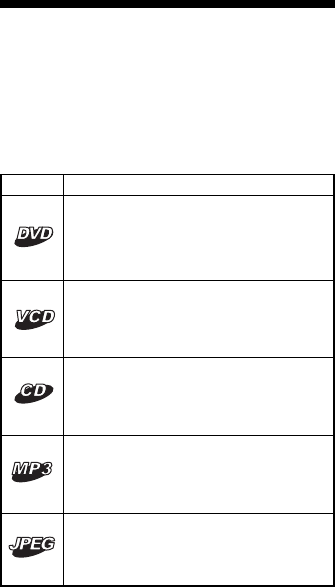
5
About this manual
Conventions
•Instructions in this manual describe how to
use the player mainly by using the controls
on the supplied wireless card remote
commander.
•The icons below are used in this manual:
•While operating
— Do not insert your hands, fingers or
foreign objects into the player. It may
cause injury or damage to the player.
— Take extra care not to wind the wire of the
headphones around your neck avoiding
injury or suffocation in the event of a
sudden movement of the vehicle.
— Keep small articles out of the reach of
children.
•If the player does not work, check the
connections first. If everything is in order,
check the fuse.
•If your car was parked in direct sunlight,
allow the player to cool off before operating
it.
•Avoid installing the player in places:
— subject to temperature below 0 °C (32 °F)
or above 45 °C (113 °F)
— subject to direct sunlight
— near heat sources (such as heaters)
— exposed to rain or moisture
— exposed to excessive dust or dirt
— subject to excessive vibration
— subject to heat:
Keep the player away from nearby hot
vehicle components that heat up over
time such as hoses, high current wires,
and braking systems components. Make
sure to leave enough room for ventilation
on openings and slots to protect from over
heating.
If you have any questions or problems
concerning the player, please consult your
nearest Sony dealer.
Moisture condensation
On a rainy day or in a very damp area,
moisture condensation may occur inside the
lenses. Should this occur, the player will not
operate properly. In such a case, remove the
disc and wait for about an hour until the
moisture has evaporated.
To maintain high sound quality
Be careful not to splash juice or other soft
drinks onto the player or discs.
Icon Meaning
Functions available for DVD
VIDEOs or DVD-Rs/DVD-RWs in
video mode
Functions available for Video CDs
or CD-Rs/CD-RWs in video CD
format
Functions available for music CDs
or CD-Rs/CD-RWs in music CD
format
Functions available for files in MP3
format stored on CD-ROMs/CD-
Rs/CD-RWs
Functions available for files in
JPEG format stored on CD-ROMs/
CD-Rs/CD-RWs
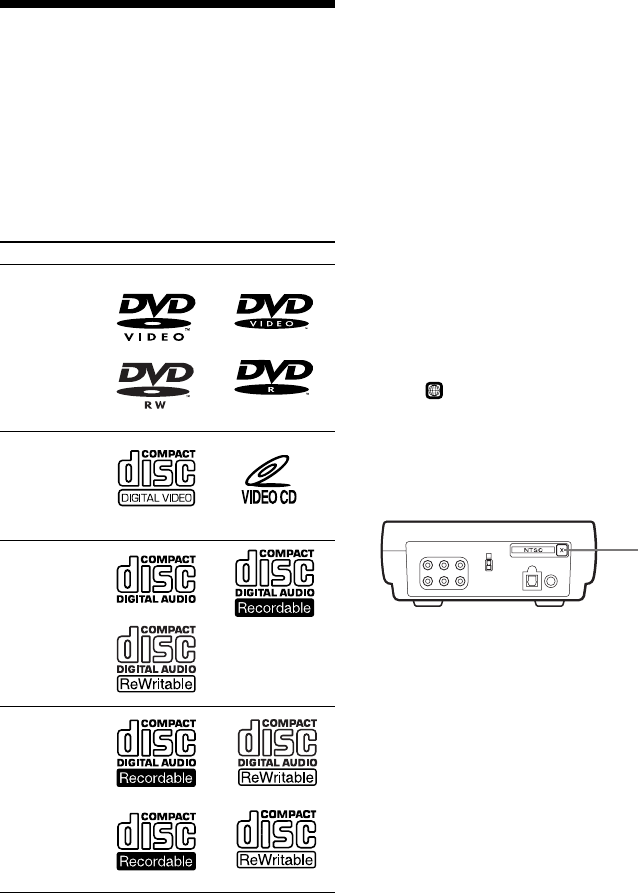
6
Region
code
About discs this player can
play
This player can play the following discs:
•DVD
•DVD-R
•DVD-RW
•Video CD
•Audio CD
•CD-R/CD-RW
Disc type Label on the disc
DVD Videos
Video CDs
Audio CDs
MP3 files/
JPEG files
“DVD VIDEO,” “DVD-R” and “DVD-RW” are
trademarks.
Notes on CD-Rs (recordable CDs)/
CD-RWs (rewritable CDs)
•Some CD-Rs/CD-RWs (depending on the
equipment used for its recording or the
condition of the disc) may not play on this
player.
•You cannot play a CD-R/CD-RW that is not
finalized*.
•You cannot play a CD-R/CD-RW that is
recorded in Multi Session.
•You can play MP3/JPEG files recorded on
CD-ROMs, CD-Rs, and CD-RWs.
*A process necessary for a recorded CD-R/CD-RW
disc to be played on the audio CD player.
Region code of DVDs this player
can play
This player has a region code printed on the
rear of the player and will only play DVDs that
are labeled with identical region codes. DVDs
labeled
ALL
will also be played on this player.
If you try to play any other DVD, the message
“REGION ERROR” will appear on the screen.
Depending on the DVD, the region code
indication may not appear even if the DVD is
prohibited by area restrictions.
Cautions
• This player CANNOT play these discs.
— DVD-Audio — DVD-RAM
— DVD-ROM — CD-G
— SVCD — CD-I
— Photo-CD — VSD
— Active-Audio (Data)
— CD-Extra (Data)
— Mixed CD (Data)
— CD-ROM (the data other than the MP3/JPEG
file)
— DVD-RW recorded in VR mode
• This product incorporates copyright protection
technology that is protected by method claims of
certain U.S. patents and other intellectual
property rights owned by Macrovision
Corporation and other rights owners. Use of this
copyright protection technology must be
authorized by Macrovision Corporation, and is
intended for home and other limited viewing
uses only unless otherwise authorized by
Macrovision Corporation. Reverse engineering or
disassembly is prohibited.
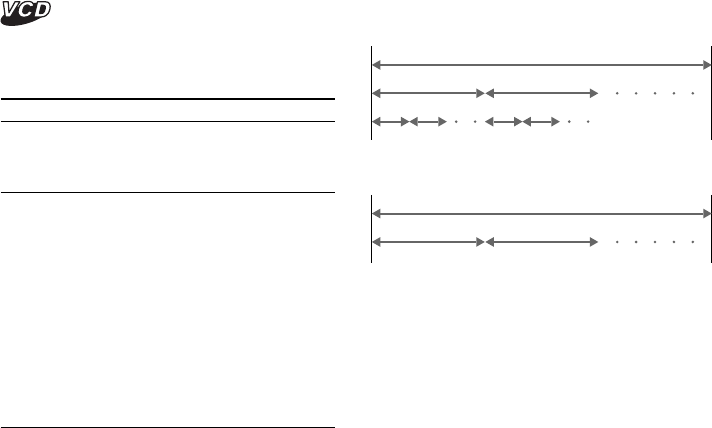
7
Note on PBC (Playback Control)
This player conforms to Ver. 1.1 and Ver. 2.0 of
Video CD standards. You can enjoy two kinds
of playback according to the disc type.
Disc type
Video CDs without
PBC functions
(Ver. 1.1 discs)
Video CDs with
PBC functions
(Ver. 2.0 discs)
Note on DTS-encoded CDs
When playing DTS*-encoded CDs, excessive
noise will be heard from the analog stereo
outputs. To avoid possible damage to the
audio system, the consumer should take
proper precautions when the analog stereo
outputs of this player is connected to an
amplification system. To enjoy DTS Digital
Surround™ playback, an external 5.1-channel
DTS Digital Surround™ decoder system must
be connected to the digital output of this
player.
* “DTS,” “DTS Digital Surround” and “DTS Digital
Out” are trademarks of Digital Theater Systems,
Inc.
Terms for discs
DVD structure
Disc
Title
Chapter
You can
Video playback (moving
pictures) as well as music.
• Interactive software
with menu screens
displayed on the
monitor
(PBC Playback, page
20).
• Video playback
functions.
• High-resolution still
pictures if they are
included on the disc.
Video CD/Audio CD structure
• Title
The longest section of a picture or music
feature on a DVD, e.g., a movie for video
software, or an album for audio software, etc.
•Chapter
Sections of a picture or a music feature that
are smaller than titles. A title is composed of
several chapters. Each chapter is assigned a
chapter number enabling you to locate the
chapter you want. Depending on the disc,
chapters may not be recorded.
•Track
Sections of a picture or a music feature on a
Video CD/Audio CD. Each track is assigned
a track number enabling you to locate the
track you want.
•Scene
On a Video CD with PBC (playback control)
functions, the menu screens, moving pictures
and still pictures are divided into sections
called “scenes.” Each scene is assigned a
scene number enabling you to locate the
scene you want.
Track
Disc
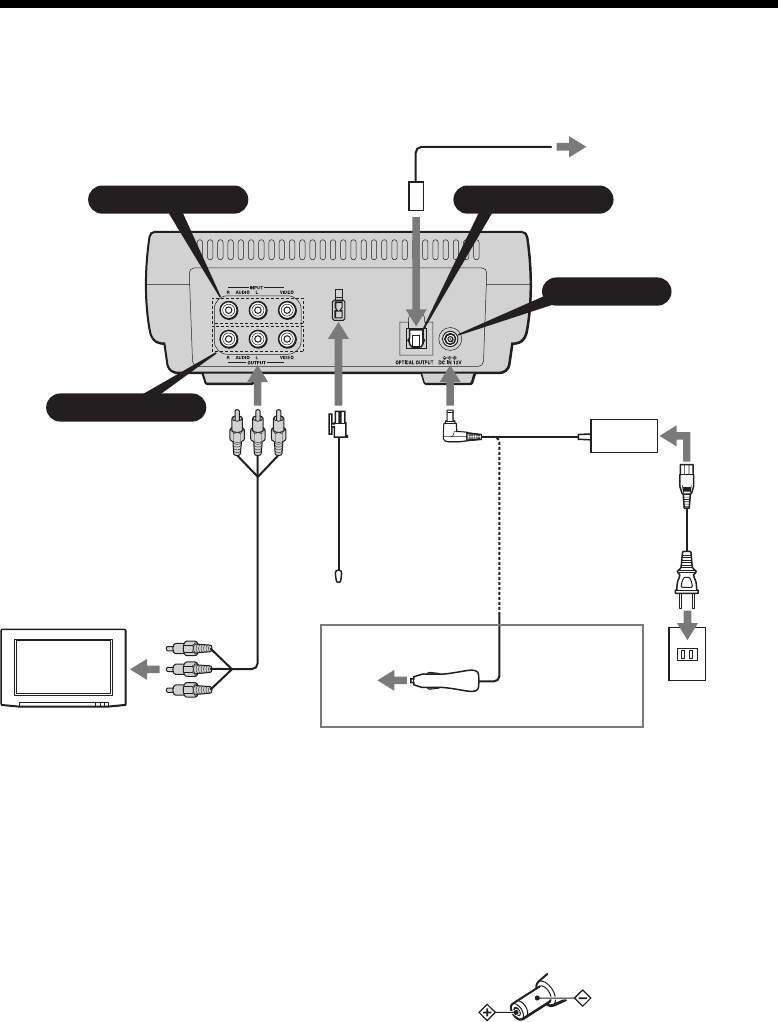
8
Connection
On AUDIO/VIDEO OUTPUT
connectors
You can connect a TV to the AUDIO/VIDEO
OUTPUT connectors to output the contents
being played back on the player. Connect the
yellow plugs of the audio/video cable to the
video connectors on both the TV and the
player and connect the white plugs and the red
plugs to the white (left audio) connectors and
red (right audio) connectors respectively.
On AUDIO/VIDEO INPUT connectors
You can connect a VTR, etc. to the AUDIO/
VIDEO INPUT connectors to input the
contents being played back on the device. You
can connect the device in the same way as
described on “On AUDIO/VIDEO OUTPUT
connectors” above.
Optical cable
(not supplied) To a digital
amplifier, etc.
AUDIO/VIDEO INPUT OPTICAL OUTPUT
DC IN 12V
AUDIO/VIDEO OUTPUT
Two headphones
connectors
(at the side)
AC power
adaptor
(supplied)
Audio/video
cable
(not supplied)
Antenna for FM
transmission
(supplied)
Power cord for the
cigar lighter socket
(supplied)
TV, etc.
To audio/video
input connectors
To the cigar lighter socket
When using the
player in the car
To a
wall
outlet
Notes
•When connecting the other device to the player,
be sure to connect the player to the power
source after all other connections are completed.
•If an obstacle such as cigar ash is caught inside
the cigar lighter socket, the contact between the
power cord plug and the socket becomes
incomplete and the plug may get extremely hot
during use. To avoid this, check the socket and
clean it if necessary before connecting the power
cord.
* Polarity of the plug
This player is supplied with two types of
power cable. When you use the player in the
car, connect the player to the cigar lighter
socket; when using at home, connect it to the
AC outlet.
*
AC power cord
(supplied)
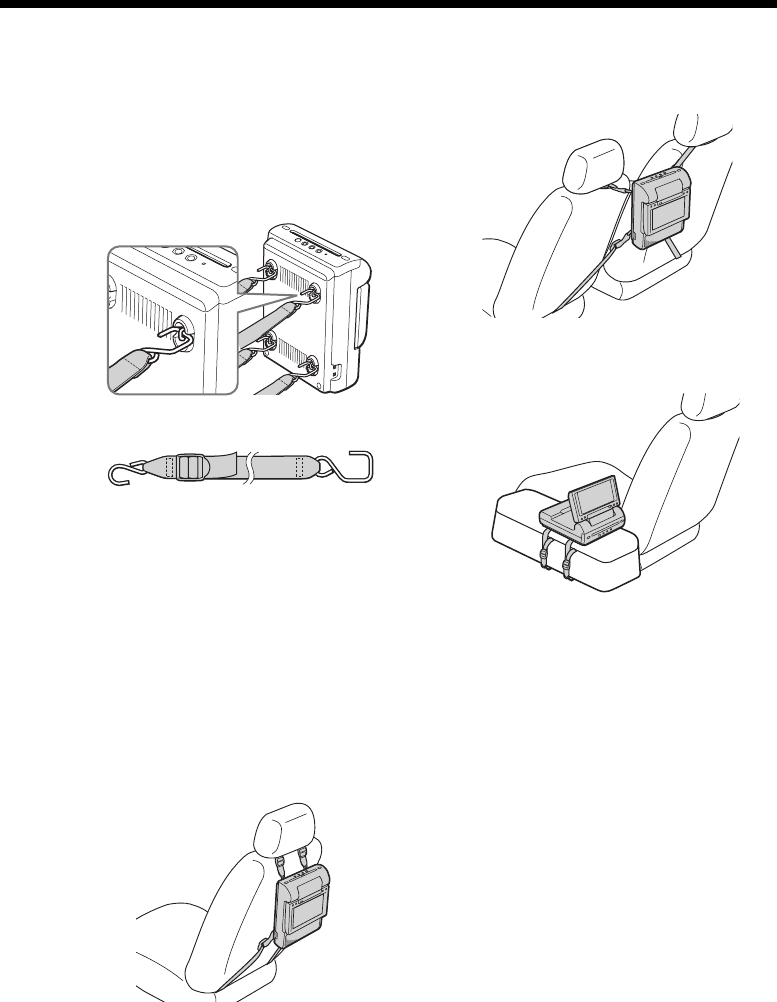
9
Installing the player in the car
The player can be installed in the car by using
the supplied mounting straps.
1Attach the angled hook on each of the
supplied mounting straps to the four
brackets at the bottom of the player.
2Attach the round hooks to the car.
Be sure to hook the player to a steady
objects such as the headrest shafts of the
seat or the seat rails.
When you attach the player to the center
console, secure the round hooks to the
bottom edge of the console.
3Take in the slack of the belts to secure
the player.
Example when the player is attached behind
the seat
Example when the player is attached between
the seats
Example when the player is attached to the
center console
continue to next page t
To the car To the player
Round hook Angled hook
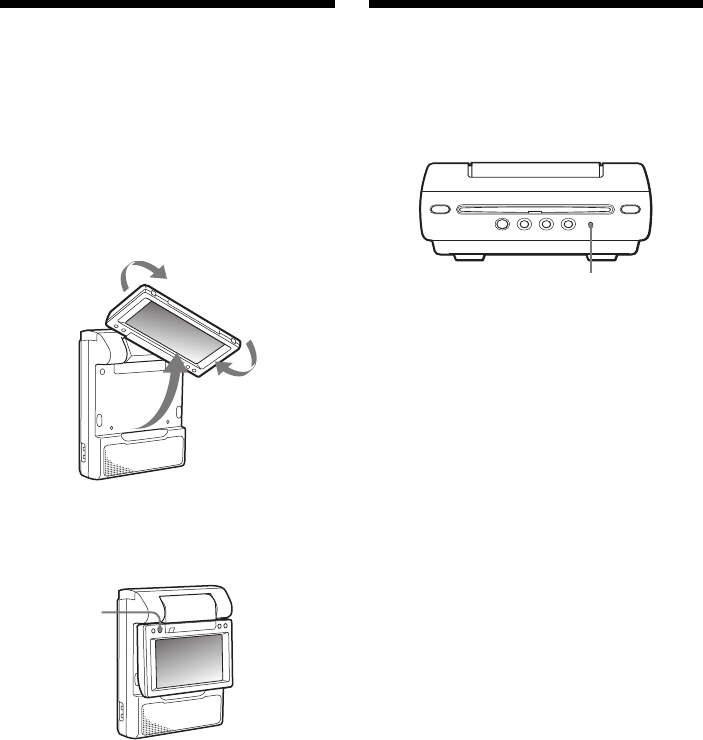
10
REVERSE
Resetting the player
Before operating the player for the first time,
you must reset the player.
Press (RESET) with a pointed object, such as a
ballpoint pen. Pushing it with force by using a
needle may damage the player.
Notes
• When you press (RESET), some of the previous
settings may be lost. If this occurs, make the
settings again.
•It takes about 10 seconds for the player to reset
itself after pressing (RESET). Do not insert a disc
during this time. If you do, the player may not be
reset properly.
RESET
When the player is installed behind
the seat or between the seats
The player is installed upside down.
Do the procedure below to turn the picture on
the screen upside down and switch the audio
channels to use the player.
1Open the monitor of the player, rotate it
in 180 degrees, then close it with the
screen facing upward.
2Turn on the player, then press
(REVERSE) on the monitor.
To cancel this, press (REVERSE) again.
When the player is attached to the center console
•When picture noise appears or the sound
dropouts occur due to vibrations from the car,
place a cushioning material under the player.
• If a gap exists between the top of the center
console and the bottom of the player, fill the
gap with a material with optimum thickness so
that the player becomes stable.
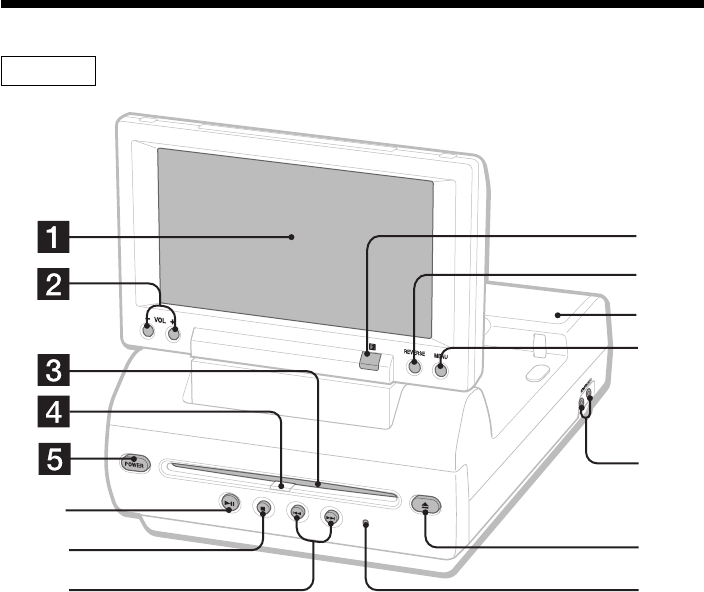
11
MV-65ST
DISC IN
RESET
6
7
8
9
0
qa
qd
qs
qf
qg
Refer to the pages listed for details.
1Monitor
2VOL –/+ buttons 13, 27
To turn up or down the volume or to select
the item during menu operation.
3Disc slot
4DISC IN light
When a disc is in the player, the DISC IN
light glows orange.
5POWER (on/off) button 13
To turn on/off the player.
6u (play/pause) button 13, 14, 15, 20
7x (stop) button 14, 15
8. (previous)/> (next) buttons 14,
20
9Receptor for the card remote
commander
q; Reverse button 10, 30
To switch images upside down and
reverse the output of the audio channels.
qa Speakers (left/right)
qs MENU button 27
To make various display settings and FM
transmitter setting.
qd HEADPHONES jacks
To connect the headphones. 2 sets of
headphones can be connected.
qf Z (eject) button 14
Available to eject a disc from the player
even when the player is turned off.
qg RESET button 10
Note
Even when the player is turned off by pressing
(POWER), you can eject a disc from the player,
though you cannot insert a disc.
continue to next page t
Location of controls
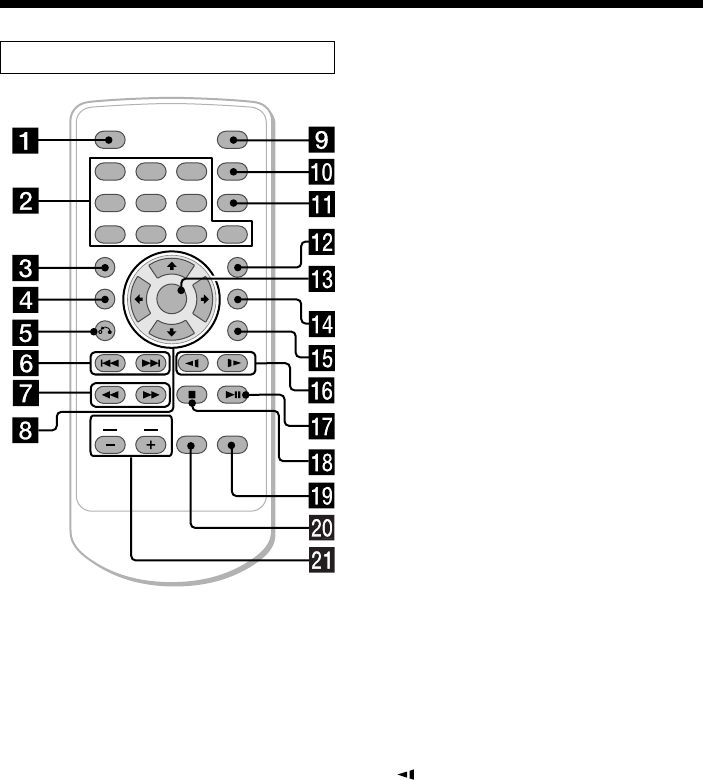
12
Card remote commander RM-X137
ENTER
SEARCH
POWER
DISPLAY
CLEAR
SETUP
AUDIO
ANGLE
SUBTITLE
MENU
TOP MENU
INPUT
123
456
7890
VOL
Refer to the pages listed for details.
1DISPLAY button 16
To display the time information of the disc.
2Number buttons (0 to 9) 14, 20, 24
3TOP MENU button 18
To display the top menu of a recorded
DVD.
4MENU button 18, 20
To display the recorded DVD menu, or to
turn on/off the PBC (Playback control)
menu of a Video CD.
5O (return) button 20
6./> (previous/next) buttons 14, 20
7m (fast reverse)/
M (fast forward) buttons 14
8M/,/m/< buttons 14, 15, 18, 21
9POWER (on/off) button 13
To turn on/off the player.
q; SEARCH button 14
To specify a desired point on a disc by
chapter, title, or track.
qa CLEAR button
qs SUBTITLE button 17
To change the subtitle language while
playing a DVD.
qd ENTER button 14, 21
To enter a setting.
qf ANGLE button 19
To select the multiple angles of view while
playing a DVD.
qg AUDIO button 19
To change the audio output/audio
language.
qh (slow reverse)/y (slow forward)
buttons 14
qj u (play/pause) button 13, 14, 15, 20
qk x (stop) button 14, 15
ql SETUP buttons 22
Used to perform menu operations.
w; INPUT button 26
To select the input source.
wa VOL (–/+) buttons 13, 27
To turn up or down the volume.
The corresponding buttons of the card
remote commander control the same
functions as those on the player.
Instructions in this manual describe how to use
the player by mainly using the card remote
commander.
Tip
Refer to “Replacing the lithium battery of the card
remote commander” for details on how to replace
the battery (page 31).
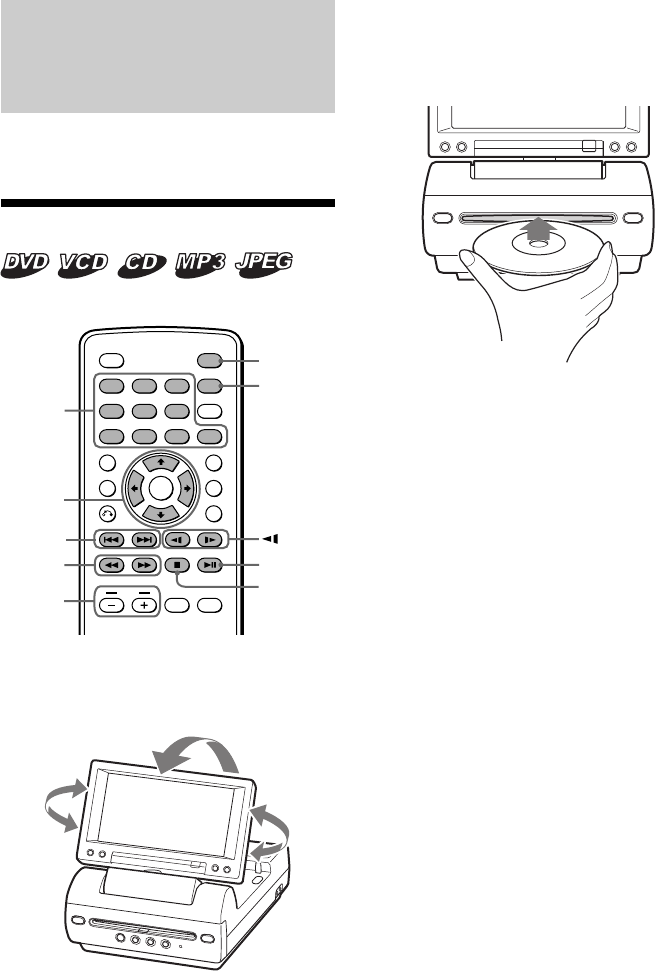
13
Various Playback
This chapter describes various functions for
playback.
Playing a disc
ENTER
SEARCH
POWER
DISPLAY
CLEAR
SETUP
AUDIO
ANGLE
SUBTITLE
MENU
TOP MENU
INPUT
123
456
7890
VOL
./>
u
x
POWER
SEARCH
M/m
</,
/y
m/M
VOL
1Open the monitor and adjust the tilt and
swivel.
2Press (POWER) to turn on the player.
The monitor turns on and the green light of
the POWER switch on the player lights up.
Number
buttons
3Insert the disc (labeled side up) into the
player.
Playback starts automatically.
If a disc is already inserted or playback does
not start automatically, press u to start
playback.
4Press (VOL) (+) or (VOL) (–) on the card
remote commander to adjust the
volume.
To turn off the power
Press (POWER) so that the green light of the
POWER switch on the player turns off.
After use
Turn off the player and disconnect the power
cord from the power source.
Note on using the player in the car
Using the player while the ignition key is in
ACC position and the engine is stopped may
cause the car battery to run down.
Notes
•Even when the player is turned off, you can eject
a disc from the player, though you cannot insert
a disc.
•Read the instruction manual supplied with the
disc to play with this player.
•When you play an 8-cm disc (e.g., CD-single), be
sure to insert it to the center area of the disc slot.
•Depending on the recording method used on the
disc, it may take a minute or more before
playing.
•Depending on the condition of the disc, it may
not play back (page 32).
•A high-bit rate MP3 file such as 320 kbps may not
play back properly.
continue to next page t
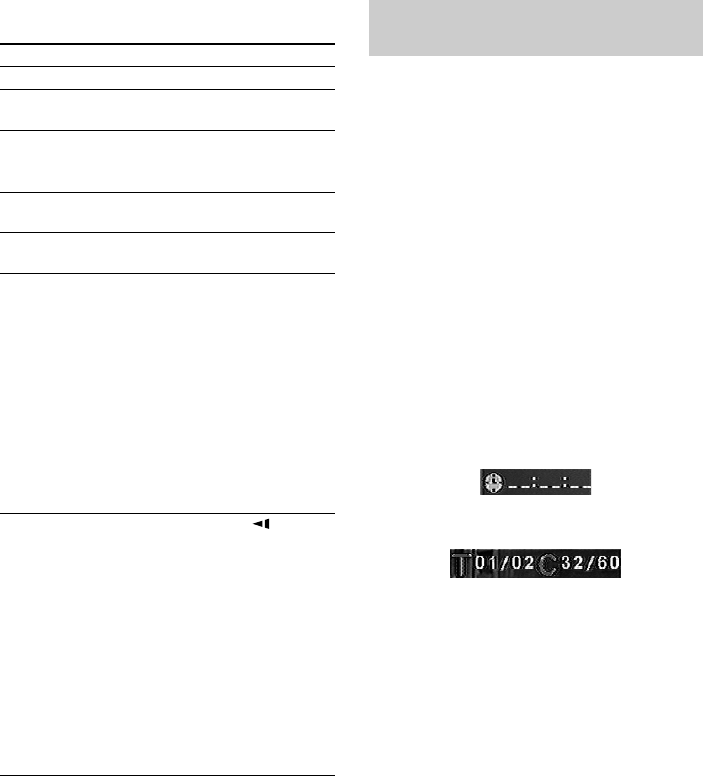
14
Operation for playback
To Do this
Stop playback Press x*1
Eject the disc Press Z on the
player.
Pause Press u *2.
Press again to
resume playback.
Go to the next chapter, Press >
track, or scene
Go back to the preceding Press .
chapter, track, or scene
Fast forward/ Press M/m while
fast reverse playing*3 *4
Each press changes
the playback speed
as follows: 2 times
normal speed
t 4 times normal
speed t 8 times
normal speed t 16
times normal speed
t 32 times normal
speed t normal
playback speed.
Slow forward Press y/ while
(DVD/Video CD only)/ playing *4
Slow reverse Each press changes
(DVD only) the playback speed
as follows: 1/2 times
normal speed t 1/4
times normal
speedt 1/8 times
normal speedt 1/
16 times normal
speedt 1/32 times
normal speedt
normal playback
speed.
*1If the resume playback function is activated, you
can resume playback later by pressing u. For
details, see “Resume playback” (page 15).
*2 DVD/Video CD/Audio CD/MP3/JPEG
“X” is displayed on the screen.
*3 DVD/Video CD/Audio CD/MP3/JPEG
No sound is output during fast forward or fast
reverse.
*4 A disc other than a DVD returns to normal
playback when a track/MP3 file finishes.
Searching a chapter/title/track
directly
1During playback or pause, press
(SEARCH) to display search screen.
•DVD*1
Each time you press (SEARCH), the
search screen changes as follows: “TIME
SEARCH,” “SELECT TITLE,” and “OFF.”
When you press < or , button while
“SELECT TITLE” is displayed in the
screen, the screen toggles between
“SELECT CHAPTER” and “SELECT
TITLE.”
•Video CD (only when PBC is off)/Audio
CD*2
Each time you press (SEARCH), the
search screen toggles between “TIME
SEARCH” and “SELECT TRACK.”
2Press the number buttons to enter the
desired chapter/title/track number.
When “TIME SEARCH” is displayed
When “SELECT TITLE,” “SELECT CHAPTER,” or
“SELECT TRACK” is displayed
3Press (ENTER).
*1Search is possible even while the player is
stopped.
*2 You can use the number buttons on the card
remote commander to select the track.
Note
You cannot set “0.”
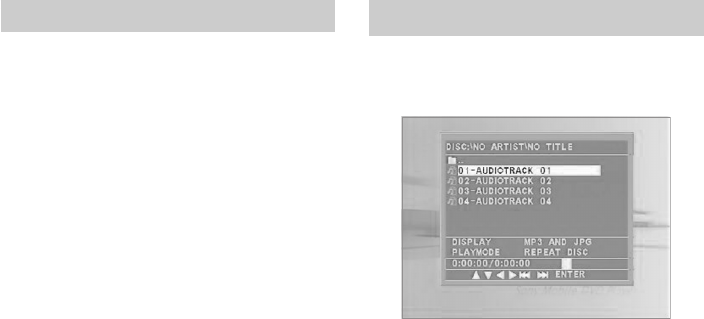
15
Resume playback
You can resume playback from the point
where the playback has been stopped. The
player memorizes the point even after the
power is turned off.
1During playback, press x to stop.
The player memorizes the point where
playback is stopped.
•DVD/Video CD/Audio CD
“PRESS PLAY KEY TO LASTPLAY”
appears on the screen.
2Press u to start playback.
“LASTPLAY” appears on the screen and
playback starts from the point where
playback has been stopped.
•MP3/JPEG
When resume playback is activated,
playback starts from the beginning of the
MP3/JPEG file (track) during which you
have stopped playback.
Notes
• To deactivate the resume function, press x again
while playback is stopped. “PRESS PLAY KEY TO
PLAY” appears on the screen at this time.
• The resume function will be deactivated when
the disc is ejected.
• The resume function will also be deactivated
when the ignition key is turned to OFF position
or when the player is disconnected from the
power source.
Using MP3/JPG menu
When you insert a disc containing MP3 or
JPEG files, playback automatically starts and
the MP3/JPG menu appears on the screen.
To make settings on the MP3/JPG menu, press
x to stop the player.
To select a folder or a file
While the player is stopped, use M/m buttons
to select the folder or a file, then press
(ENTER).
When you press (ENTER) after selecting a
folder, files inside the folder appear.
To select the display mode
While the player is stopped, use ,/<
buttons to select “DISPLAY,” then press
(ENTER) repeatedly to select the display
mode.
Each time you press (ENTER), display mode
changes as follows: MP3 ONLY (only MP3
files are displayed) t JPG ONLY (only JPEG
files are displayed) t MP3 AND JPG (MP3
files and JPEG files are grouped and
displayed).
To select the playback mode
While the player is stopped, use ,/</m
buttons to select “PLAYMODE,” then press
(ENTER) repeatedly to select the playback
mode.
Each time you press (ENTER), playback mode
changes as follows: REPEAT DISC (repeats all
the tracks on the disc) t NORMAL (normal
playback) t REPEAT DIR (repeats all the
tracks within the directory) t REPEAT ONE
(repeats one track) t RANDOM (plays tracks
at random; the same track may be played more
than once) t SHUFFLE (plays tracks at
random; tracks are played only once).
continue to next page t
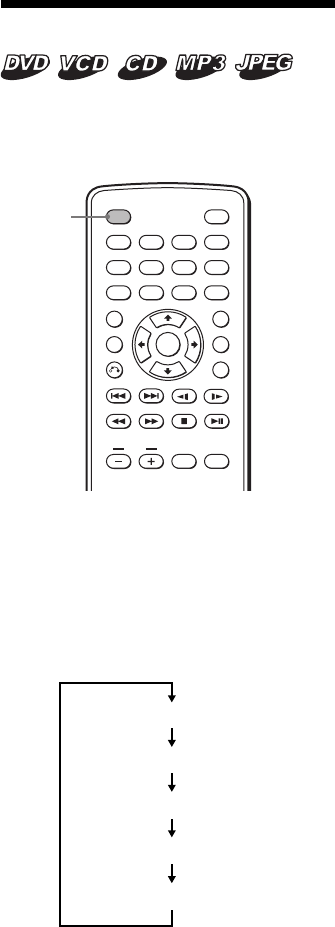
16
Displaying elapsed time
You can display the elapsed time and the
remaining time of DVDs, Video CDs and
Audio CDs.
ENTER
SEARCH
POWER
DISPLAY
CLEAR
SETUP
AUDIO
ANGLE
SUBTITLE
MENU
TOP MENU
INPUT
123
456
7890
VOL
DISPLAY
During playback, press (DISPLAY).
The elapsed time or the remaining time is
displayed at the upper left.
Each time you press (DISPLAY), the display
changes as follows:
•DVD
Elapsed time of the title
Remaining time of the title
Elapsed time of the chapter
Remaining time of the chapter
OFF (default display)
Notes
•While playing back, you cannot change a folder
or file with the MP3/JPG menu. Only the files in
the selected folder can be selected with the ./
> button. To change the folder, stop playback.
•Names for the MP3 folders and files are
displayed properly when they consist of
alphabets, numbers, or symbols only. Folders and
files containing other characters are displayed as
“DIR--001” or “FILEOPEN--001.”
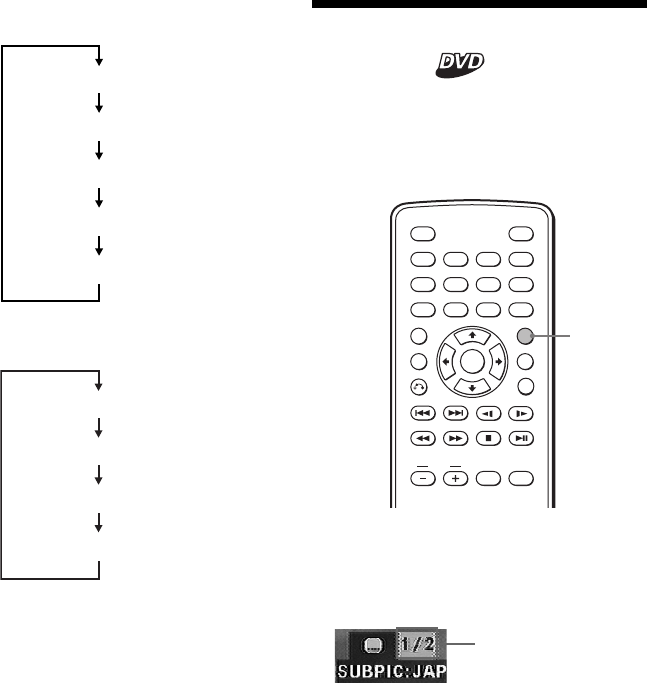
17
•Video CD
•Audio CD
To turn off the time information
Press (DISPLAY) repeatedly to select “OFF.”
Elapsed time of the disc
Elapsed time of the track and audio
mode (stereo/mono)
Elapsed time of the track and PBC
setting (ON/OFF)
Remaining time of the track
OFF (default display)
Changing the subtitle
language
Some DVDs have recorded subtitles in one or
more languages. You can turn the subtitles on
or off, or change the subtitle language on such
DVDs.
ENTER
SEARCH
POWER
DISPLAY
CLEAR
SETUP
AUDIO
ANGLE
SUBTITLE
MENU
TOP MENU
INPUT
123
456
7890
VOL
SUBTITLE
Press (SUBTITLE) during playback.
The subtitle language is displayed at the
upper left.
Example: a subtitle language display
Each time you press (SUBTITLE), the
language switches within the list of subtitle
languages recorded on the disc.
To turn off the subtitle
Press (SUBTITLE) repeatedly to select “OFF.”
Notes
• You can also change the subtitle languages by
changing Setup*. See “Displaying the subtitles
for DVD — SUBTITLE” (page 23).
* You can change to a specific subtitle language
using the DVD SETUP menu, only if the
language is included in both the disc and the
menu. In some discs, the initial language to be
displayed is specified regardless of the DVD
SETUP menu setting.
• This function varies or may not work, depending
on the DVD.
The disc contains 2
subtitle languages and
the first language is
currently selected.
Remaining time of the disc
Elapsed time of the disc
OFF
Elapsed time of the track
(default display)
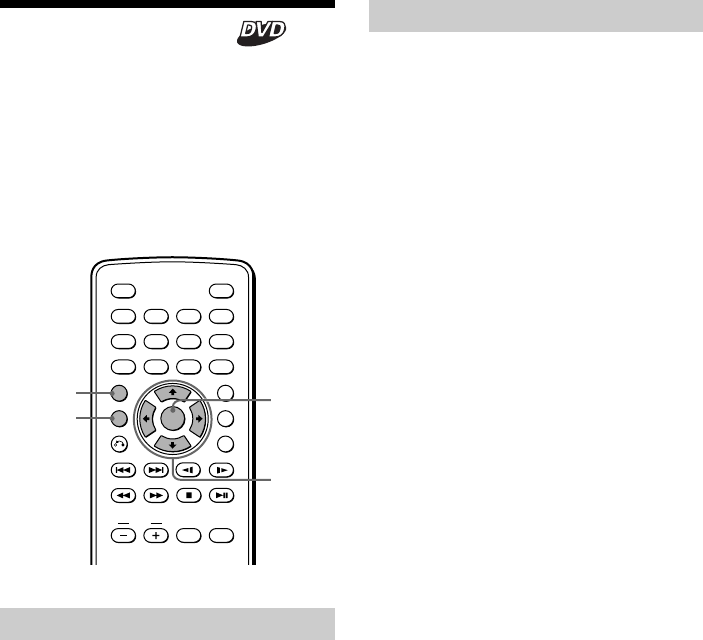
18
Using the MENU button
Some DVDs have more comprehensive menu
that includes such things as the audio
languages, subtitle languages, titles, and
chapters, etc.
1During a DVD playback, press (MENU).
The DVD menu is displayed.
2Press M/,/m/< to select the desired
item.
3Press (ENTER).
If additional selection screens appear,
repeat step 2 and 3.
Notes
• Some DVDs do not have a DVD menu and on
some DVDs, the contents of the DVD menu and
title menu are the same.
• On some DVDs, “DVD Menu” may be expressed
as “MENU.”
• On some DVDs, “Press ENTER” may be expressed
as “Press SELECT” in step 3.
• The contents of the DVD menu differ, depending
on the DVD.
• Read the instruction manual supplied with a
DVD.
Using a DVD menu
With some DVDs you can use the original
menu such as Title menu and DVD menu. In
title menu, you can play your favorite scene or
song by selecting titles of songs and scenes.
You can select an item, subtitle language,
audio language etc. by selecting a DVD menu.
The contents of title menus and DVD menus
differ, depending on the DVD. There may be
some DVDs which have no recorded menus.
ENTER
SEARCH
POWER
DISPLAY
CLEAR
SETUP
AUDIO
ANGLE
SUBTITLE
MENU
TOP MENU
INPUT
123
456
7890
VOL
TOP MENU
MENU
ENTER
M/m
</,
Using the TOP MENU button
Some DVDs have a title menu. From the title
menu you can select a title for playback. Titles
are the longest sections of a picture or music
feature on a DVD, e.g., a movie, or an album
for audio software, etc. The TOP MENU
button is available to display the initial menu
screen.
1During DVD playback, press (TOP MENU).
The title menu* (top menu) is displayed.
* The contents of the title menu differ,
depending on the DVD.
2Press M/,/m/< to select the desired
title.
3Press (ENTER).
The title you selected starts to play.
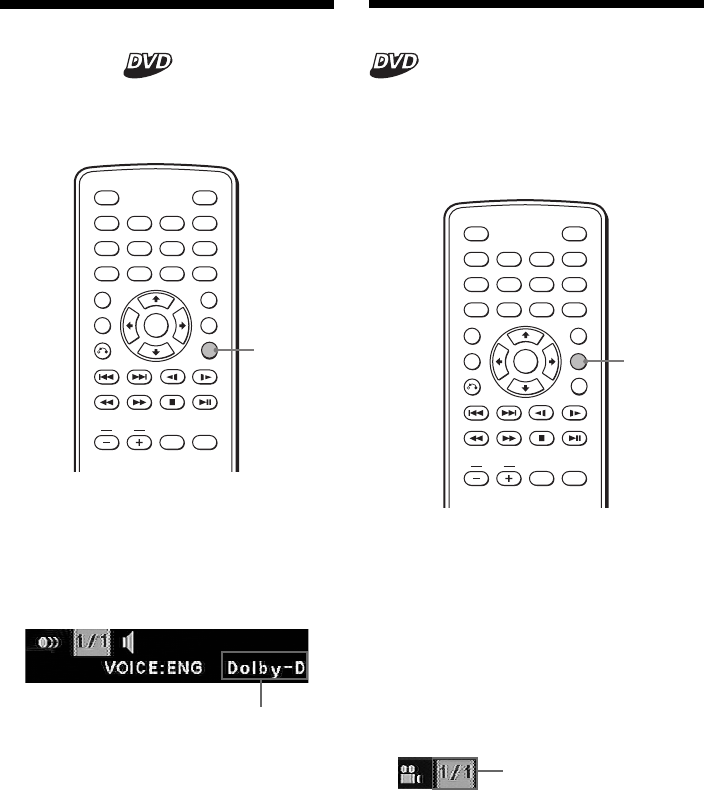
19
Changing the audio
language
Some DVDs have multiple audio languages
you can choose from.
ENTER
SEARCH
POWER
DISPLAY
CLEAR
SETUP
AUDIO
ANGLE
SUBTITLE
MENU
TOP MENU
INPUT
123
456
7890
VOL
AUDIO
During playback, press (AUDIO)
repeatedly to select the desired audio
language.
The current audio language is displayed at
the upper left.
Example: an audio language display
When the display for the language code
appears, input the language code
corresponding to the desired language
(page 37).
Notes
• You can switch the audio language only if
multiple audio languages are recorded on the
DVD.
• You can also change the audio languages by
using the DVD menu (page 18) or the DVD SETUP
menu* (page 22).
* You can change to a specific audio language
using the DVD SETUP menu, only if the
language is included in both the disc and the
menu. In some discs, the initial language to be
output is specified regardless of the DVD SETUP
menu setting.
• This function varies or may not work, depending
on the DVD.
The format of the sound source
(Dolby D, DTS, or LPCM) may appear.
Changing angles
Some DVDs have multiple alternative angles
recorded for certain scenes. If you have set
“ANGLE MARK” to “ON” (page 23), a notice
appears at the scene.
ENTER
SEARCH
POWER
DISPLAY
CLEAR
AUDIO
ANGLE
SUBTITLE
MENU
TOP MENU
INPUT
123
456
7890
VOL
SETUP
ANGLE
1During playback of a DVD having
multiple alternative angles recorded,
press (ANGLE) when a notice appears.
The number of the currently selected angle
is displayed at the upper right.
2Press (ANGLE) repeatedly to select your
favorite angle number, while the angle
number is displayed.
Each time you press (ANGLE), the angle
number switches.
Notes
• You can switch the angle only if multiple angles
are recorded on the DVD.
• The total number of recorded angles differs
depending on the DVD and scene.
• You can switch the angle only during normal
playback. You cannot switch the angle during
fast forward/reverse playback.
• When the selected scene with multi angles
appears, the angle is automatically switched to
the angle number you selected in step 2.
• This function varies or may not work, depending
on the DVD.
The angle number you
have currently selected/
the total number of
multiple alternative
angles
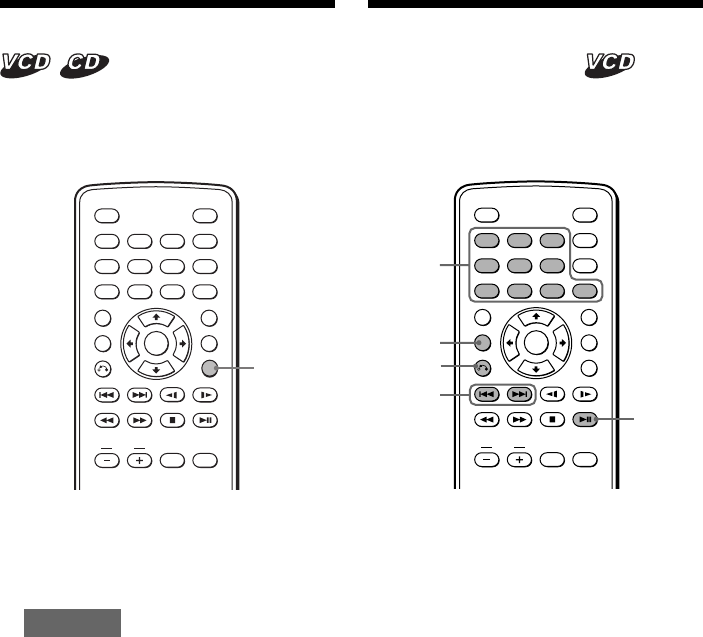
20
Using the PBC (playback
control) function
During playback of a PBC compatible Video
CD, you can display the PBC menu and select
the item from the menu.
ENTER
SEARCH
POWER
DISPLAY
CLEAR
SETUP
AUDIO
ANGLE
SUBTITLE
MENU
TOP MENU
INPUT
123
456
7890
VOL
MENU
./>
u
O
1Insert a Video CD, then press
(MENU) repeatedly to select “PBC ON.”
Depending on the Video CD, the PBC menu
may be displayed automatically after
inserting a Video CD.
Each time you press (MENU), the PBC
menu function turns on or off.
2Press u.
The PBC menu is displayed.
3While the PBC menu screen is displayed;
— press the number buttons to select the
number of the desired item.
— press ./> to go to the previous/
next page.
Button functions vary or may not work,
depending on the Video CD.
Notes
• To display the PBC menu during playback of a
Video CD, press (MENU) repeatedly to select
“PBC ON,” then press u.
• During playback of a Video CD with “PBC ON,”
press ./> to change the item. The PBC
menu is not displayed but the item you selected
starts to play.
• During playback of a Video CD with “PBC ON,”
press O to display the PBC menu and the B
mark.
• The PBC menus differ, depending on the Video
CD. Read the instruction manual supplied with
the Video CD.
Changing the audio output
You can select the desired audio output from
“STEREO” or “L-MONO/R-MONO” during
Video CD or Audio CD playback.
ENTER
SEARCH
POWER
DISPLAY
CLEAR
SETUP
AUDIO
ANGLE
SUBTITLE
MENU
TOP MENU
INPUT
123
456
7890
VOL
AUDIO
1During playback, press (AUDIO).
The current output is displayed at the
upper left.
Example: an audio output display
L-MONO
2Press (AUDIO) to select the desired
output from “STEREO” or “L-MONO/R-
MONO” while the output is displayed.
Each time you press (AUDIO), the output
switches.
Number
buttons
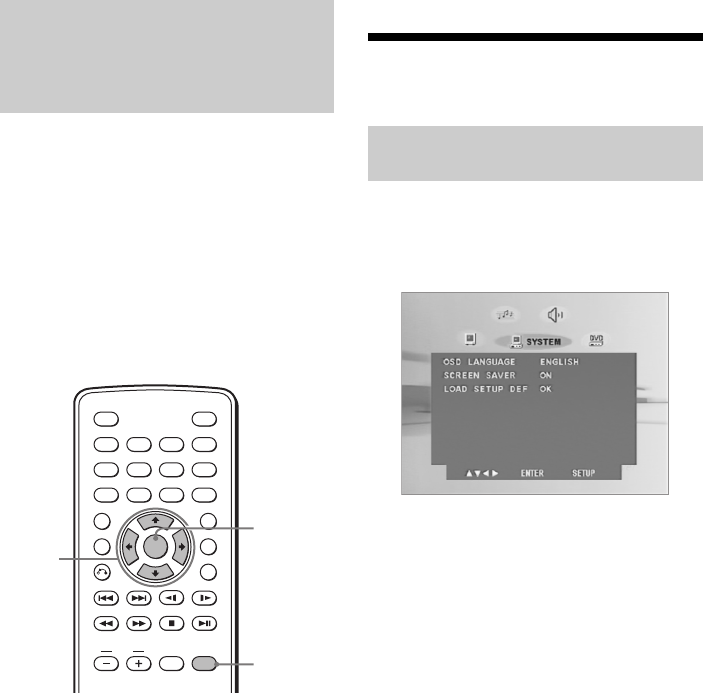
21
Changing Setup
You can set up and adjust this player using the
on-screen setup menus. Most settings need to
be set when you first use this player.
Setup menus are:
•SYSTEM menu (system settings)
•DVD SETUP menu (settings for DVD
playback)
•SPEAKER menu (setting for downmix mode)
•AUDIO menu (settings for digital audio
output)
•VIDEO menu (settings for video output)
ENTER
SEARCH
POWER
DISPLAY
CLEAR
SETUP
AUDIO
ANGLE
SUBTITLE
MENU
TOP MENU
INPUT
123
456
7890
VOL
ENTER
M/m
</,
SETUP
Refer to “Settings by using the MENU button
on the monitor” (page 27) for settings of the
monitor.
System settings — SYSTEM
menu
Selecting the language on
the menus — OSD LANGUAGE
You can select the language used for the
menus from the English and Japanese.
1Press (SETUP).
2Press M or m button repeatedly to select
“OSD LANGUAGE.”
3Press < or , button repeatedly to
select the language, then press (ENTER).
4Press (SETUP) to exit the SYSTEM menu.
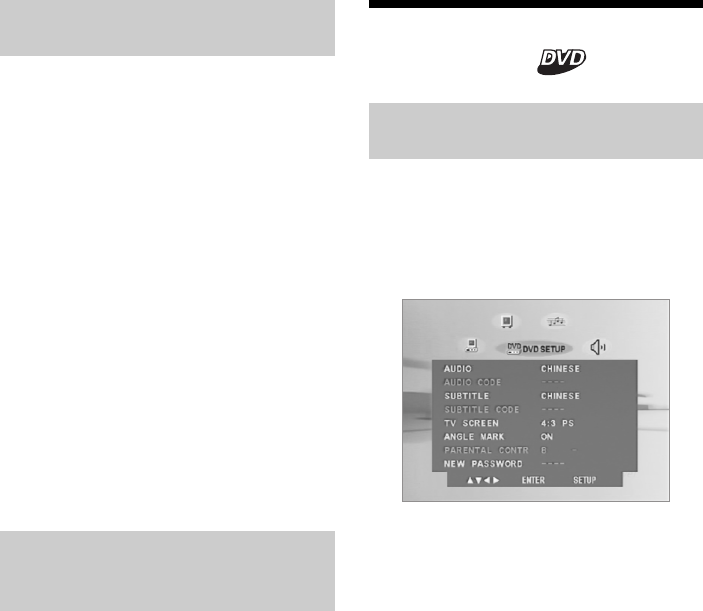
22
Setting the screen saver —
SCREEN SAVER
If you set the “SCREEN SAVER” setting to
“ON,” the screen saver image appears when
you leave the player in pause or stop mode for
more than 15 minutes. The screen saver will
help prevent the monitor from becoming
damaged.
1Press (SETUP).
2Press M or m button repeatedly to select
“SCREEN SAVER.”
3Press < or , button repeatedly to
select “ON,” then press (ENTER).
When 5 seconds elapse with no button
pressed, the player exits the SYSTEM menu
and normal display resumes.
4Press (SETUP) to exit the SYSTEM menu.
To turn off the screen saver setting
Select “OFF” in step 3.
Returning this player to the
factory setting
— LOAD SETUP DEF
You can return this player to the factory setting
except your password (page 24) and parental
setting (page 23). Follow the steps below.
Note that this operation is possible only when
the player is stopped.
1Press (SETUP).
2Press M or m button repeatedly to select
“LOAD SETUP DEF,” then press (ENTER).
3Press (SETUP) to exit the SYSTEM menu.
Settings for DVD playback
— DVD SETUP menu
Selecting the audio language
for DVD — AUDIO
Some DVDs have multiple audio languages
you can select from.
1Press (SETUP), then press < or ,
button repeatedly until “DVD SETUP”
menu appears on the screen.
2Press M or m button repeatedly to select
“AUDIO.”
3Press < or , button repeatedly to
select the language, then press (ENTER).
When you have selected “OTHER,” press M
or m button repeatedly to select “AUDIO
CODE,” then enter the language code (page
37).
4Press (SETUP) to exit the DVD SETUP
menu.
Notes
• Regardless of setting to the desired language,
other language may be automatically activated,
depending on the DVD.
• Some DVDs are prohibited to change the audio
language output, even if multiple languages are
recorded.

23
Displaying the subtitles for
DVD — SUBTITLE
If subtitles are recorded on the discs, you can
change the subtitles or turn the subtitles on
and off.
1Press (SETUP), then press < or ,
button repeatedly until “DVD SETUP”
menu appears on the screen.
2Press M or m button repeatedly to select
“SUBTITLE.”
3Press < or , button repeatedly to
select the language, then press (ENTER).
When you have selected “OTHER,” press M
or m button repeatedly to select “SUBTITLE
CODE,” then enter the language code (page
37).
4Press (SETUP) to exit the DVD SETUP
menu.
Note
Regardless of setting to the desired language,
other language may be automatically activated,
depending on the DVD.
Setting the aspect ratio for
the TV screen — TV SCREEN
When you connect the player to a TV to watch
the DVD on TV screen, make this setting
according to the type of the TV screen.
1Press (SETUP), then press < or ,
button repeatedly until “DVD SETUP”
menu appears on the screen.
2Press M or m button repeatedly to select
“TV SCREEN.”
3Press < or , button repeatedly to
select “4:3 PS,” “4:3 LB,” or “16:9,” then
press (ENTER).
4Press (SETUP) to exit the DVD SETUP
menu.
Displaying the multi-angle
notice — ANGLE MARK
If various angles (multi-angles) for a scene are
recorded on the DVD and you have set the
“ANGLE MARK” to “ON,” a notice appears at
the scene.
1Press (SETUP), then press < or ,
button repeatedly until “DVD SETUP”
menu appears on the screen.
2Press M or m button repeatedly to select
“ANGLE MARK.”
3Press < or , button repeatedly to
select “ON,” then press (ENTER).
4Press (SETUP) to exit the DVD SETUP
menu.
To turn off the angle mark
Select “OFF” in step 3.
Preparing for the initial
parental setting — PARENTAL
CONTROL
Playback of some DVDs can be limited
according to a predetermined level, such as the
age of the viewer. The Parental control
function allows you to set a playback
limitation level.
This setting is possible only when a password
is entered as described in “Setting the
password” (page 24).
1Press (SETUP), then press < or ,
button repeatedly until “DVD SETUP”
menu appears on the screen.
2Press M or m button repeatedly to select
“PARENTAL CONTR.”
3Press < or , button repeatedly to
select the limitation level, then press
(ENTER).
4Press (SETUP) to exit the DVD SETUP
menu.
continue to next page t

24
Refer to the following table. Parental levels of
the table are on the MPAA (Motion Picture
Association of America) rating system. If you
set this player to level “4” for example, DVDs
with levels “5,” “6,” “7,” and “8” cannot be
played.
This Player MPAA Rating System
“8” No restriction
“7” “NC-17”: No one 17 and
under admitted
“6” “R”: Restricted
“5” “—”:
“4” “PG-13”: Parents strongly
cautioned
“3” “PG”: Parental guidance
suggested
“2” “—”:
“1” “G”: General audience
Setting the password — PASS
WORD
When you set the password for the first time,
be sure to set the parental control together.
1Press (SETUP), then press < or ,
button repeatedly until “DVD SETUP”
menu appears on the screen.
2Press M or m button repeatedly to select
“PASS WORD.”
3Use the number buttons to enter “5370.”
“NEW PASSWORD” appears and the
player is ready to accept the new password.
4Use the number buttons to enter a new
password.
5Press (SETUP) to exit the DVD SETUP
menu.
Note
If you forget your registered password, enter
“5370.”
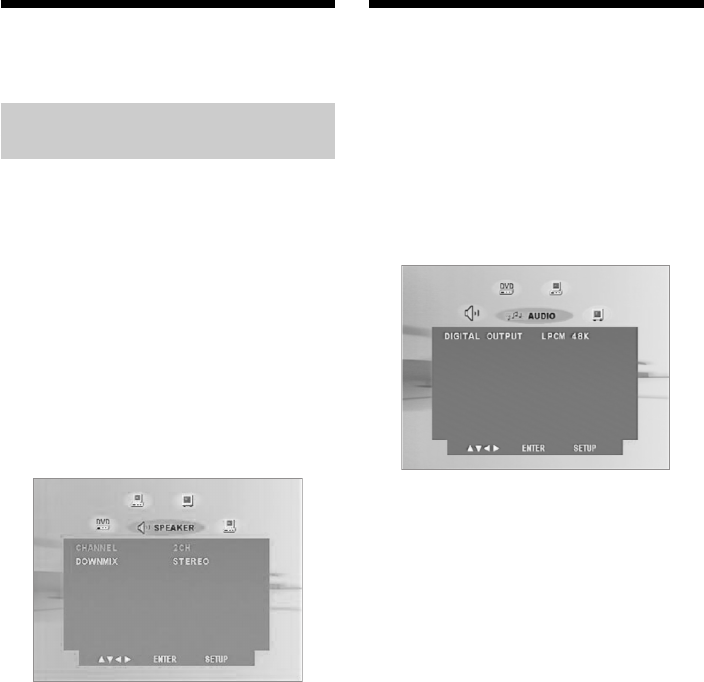
25
Selecting the speaker
mode — SPEAKER menu
Selecting the downmix mode
— DOWNMIX
You can select the downmix mode from
“STEREO” or “LT/RT.” The downmix
function is used to create stereo (2-channel)
signals from more than 5 separated digital
signals of a source.
STEREO: Select this when the connected audio
equipment does not support Dolby
Surround (Pro Logic).
LT/RT: Select this when the connected audio
equipment supports Dolby Surround
(Pro Logic).
1Press (SETUP), then press < or ,
button repeatedly until “SPEAKER” menu
appears on the screen.
2Press M or m button repeatedly to select
“DOWNMIX.”
3Press < or , button repeatedly to
select “STEREO” or “LT/RT,” then press
(ENTER).
4Press (SETUP) to exit the SPEAKER
menu.
Selecting the digital audio
output mode — AUDIO menu
You can set the mode of the audio signals
output from the OPTICAL OUTPUT
connector. “BITSTREAM” or “LPCM 48K” can
be selected.
1Press (SETUP), then press < or ,
button repeatedly until “AUDIO” menu
appears on the screen.
2Press M or m button repeatedly to select
“DIGITAL OUTPUT.”
3Press < or , button repeatedly to
select “BITSTREAM,” “LPCM 48K,” or
“OFF,” then press (ENTER).
4Press (SETUP) to exit the AUDIO menu.
Notes
•When “OFF” is selected, no signal is output from
the OPTICAL OUTPUT connector.
•When you connect the player and a digital
recording device such as an MD player through
an optical cable to record the CD contents with
that device, the contents will be recorded as one
continuous track.
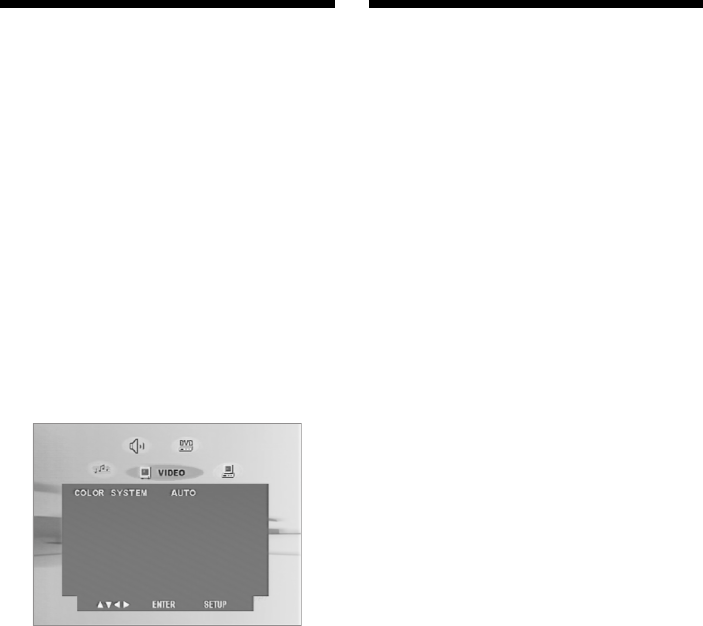
26
Selecting the color system
for the output video
signal — VIDEO menu
When you connect the player to a TV to watch
the DVD on TV screen, make this setting
according to the color system of your country.
Note that this setting does not affect the screen
of the player.
AUTO: Changes the color system for the video
signal output from the player
automatically according to the color
system recorded on the DVD.
NTSC: Always outputs the NTSC signal.
PAL: Always outputs the PAL signal.
1Press (SETUP), then press < or ,
button repeatedly until “VIDEO” menu
appears on the screen.
2Press M or m repeatedly to select “COLOR
SYSTEM.”
3Press < or , button repeatedly to
select “AUTO,” “NTSC,” or “PAL,” then
press (ENTER).
4Press (SETUP) to exit the VIDEO menu.
Monitoring video signals
input from the connected
device
Switch the input channel to monitor video
signals input from the device connected to the
VIDEO INPUT connector of the player.
1Press (POWER) to turn on the player.
The current input channel (DVD) appears
on the screen for 5 seconds.
2Press (INPUT) repeatedly to select
“VIDEO.”
Each time you press the button, “DVD” and
“VIDEO” alternate.
Be sure to change the input channel setting
to “DVD” to play the DVD with this player.
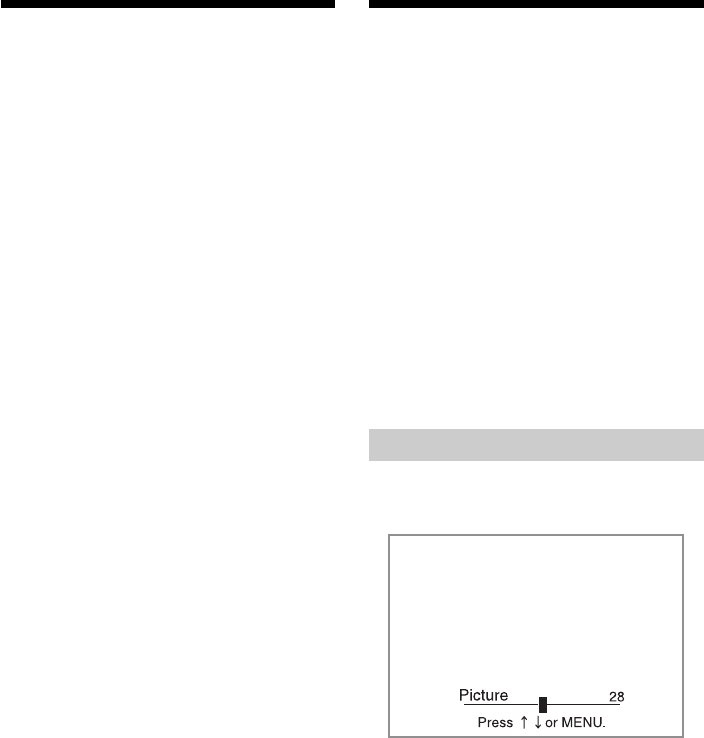
27
Selecting the color system
for the input video signal
The player detects the color system of the
input video signal (NTSC or PAL) and changes
the setting automatically (auto mode).
Do the steps below to change the color system
setting for the input video signal manually.
1Press (POWER) to turn on the player.
The current input channel (DVD) appears
on the screen for 5 seconds.
2Press (VOL) +/– on the monitor
repeatedly to select “NTSC” or “PAL.”
Note
When changed manually, color system setting for
the input video signal does not return to auto
mode until the player is turned off or input
channel setting is changed. Therefore, when it is
set to “PAL,” the DVD recorded in NTSC system
cannot be viewed on the monitor of the player
unless you turn off the player, then turn it on
again.
Settings by using the
MENU button on the
monitor
You can make settings for the monitor and
frequency for the FM transmitter by using
(MENU) on the monitor.
Each time you press (MENU), the setting
screen changes in the following sequence:
Picture t Brightness t Color t Hue*1 t
Dimmer t Video Adjust t Screen Mode t
FM Transmitter t Blue Back t Menu Off.
*1 “Hue” appears only when the NTSC color system
is selected as the input source (page 27).
Note
While making the following settings, the VOL +/–
buttons on the card remote commander can be
used to adjust the volume.
Adjusting the contrast
1Press (MENU) on the monitor.
The “Picture” screen appears.
2Press (VOL) +/– on the monitor
repeatedly to adjust the contrast.
The settable range is 0 to 63, and the default
setting is 32.
When 5 seconds elapse with no button
pressed, normal display resumes.

28
Adjusting the brightness
1Press (MENU) on the monitor repeatedly
until the “Brightness” appears.
2Press (VOL) +/– on the monitor
repeatedly to adjust the brightness.
The settable range is 0 to 63, and the default
setting is 30.
When 5 seconds elapse with no button
pressed, normal display resumes.
Adjusting the color
1Press (MENU) on the monitor repeatedly
until the “Color” appears.
2Press (VOL) +/– on the monitor
repeatedly to adjust the color.
The settable range is 0 to 63, and the default
setting is 32.
When 5 seconds elapse with no button
pressed, normal display resumes.
Adjusting the hue (NTSC
only)
1Press (MENU) on the monitor repeatedly
until the “Hue” appears.
2Press (VOL) +/– on the monitor
repeatedly to adjust the color.
The default setting is “CTR” (center).
When 5 seconds elapse with no button
pressed, normal display resumes.
Adjusting the dimmer
1Press (MENU) on the monitor repeatedly
until the “Dimmer” appears.
2Press (VOL) +/– on the monitor
repeatedly to select “On” or “Off.”
The default setting is “Off.”
When 5 seconds elapse with no button
pressed, normal display resumes.
Resetting the adjustments
You can reset the picture, brightness, color,
hue, dimmer settings at single operation.
1Press (MENU) on the monitor repeatedly
until the “Video Adjust” appears.
2Press (VOL) +/– on the monitor to reset
the settings.
When 5 seconds elapse with no button
pressed, normal display resumes.
Note
Input channel, color system for the input video
signal (NTSC/PAL), screen mode, and blue
background setting are not reset when you do the
steps above.
Setting the screen mode
The screen mode can be selected from the four
settings below:
Normal: An image with an aspect ratio of 4 to
3 (regular image).
Full: An image with an aspect ratio of 4 to
3 enlarged to the left and right edges
of the screen.
Zoom: An image with an aspect ratio of 4 to
3 enlarged to the left and right edges
of the screen, with the overflowing
parts (top and bottom) cut off to fill
the screen.
Wide: An image with an aspect ratio of 16
to 9.
1Press (MENU) on the monitor repeatedly
until the “Screen Mode” appears.
2Press (VOL) +/– on the monitor
repeatedly to select the screen mode.
The default setting is “Full.”
When 5 seconds elapse with no button
pressed, normal display resumes.

29
Setting the FM transmitter
When using the player in the car, you can
transmit the audio signals to the FM radio and
output the signals from the car stereo. Do the
procedure below to turn on or off the FM
transmitter and select the frequency.
1Press (MENU) on the monitor repeatedly
until the “FM Transmitter” appears.
2Press (VOL) +/– on the monitor to select
“On” or “Off.”
The default setting is “On.”
3To select the frequency, press (REVERSE)
on the monitor.
“Frequency” screen appears.
4Press (VOL) +/– on the monitor to select
the frequency.
The settable range is 88.3 MHz to 89.9 MHz,
in 0.2-MHz steps.
5Press (REVERSE) on the monitor to
return to “FM Transmitter” screen.
When 5 seconds elapse with no button
pressed, normal display resumes.
Notes
•If headphones are connected to the player, FM
transmitter function does not work even when
“On” is selected.
•Depending on the location in which this player is
attached, FM signals may not reach the car radio
and audio output from the car stereo may
become interrupted. If this happens, adjust the
position of the FM transmission antenna or move
the reception antenna of the car radio closer to
the player.
•If noise is heard due to the interference with the
local FM broadcast, change the FM transmission
frequency.
•When the FM transmitter is turned off, you
cannot change the frequency setting.
Setting the blue background
screen
When this item is set to “On,” the blue
background screen appears when no video
signal is received.
1Press (MENU) on the monitor repeatedly
until the “Blue Back” appears.
2Press (VOL) +/– on the monitor to select
“On” or “Off.”
The default setting is “Off.”
When 5 seconds elapse with no button
pressed, normal display resumes.
Exiting the menu operation
1Press (MENU) on the monitor repeatedly
until the “Menu Off” appears.
2Press (MENU) on the monitor again.
The normal screen resumes.
When 5 seconds elapse with no button
pressed, normal display resumes.

30
Setting the reference
volume
You can set the reference volume level for
adjusting the volume by using (VOL) +/– on
both the monitor and the card remote
commander.
Press (POWER) and press (VOL) +/– on
the monitor while no menu screen
appears.
The settable range is 0 to 47, and the default
setting is 10.
When you keep pressing down the button,
the value changes continuously.
Turning the image upside
down
To use the player in upright position, do the
following steps to turn the images on the
monitor upside down and switch the audio
channels.
Press (REVERSE) on the monitor.
“Reverse On” appears for 5 seconds and the
image on the monitor turns upside down.
To resume the normal images, press
(REVERSE) on the monitor again.
“Reverse Off” appears for 5 seconds.
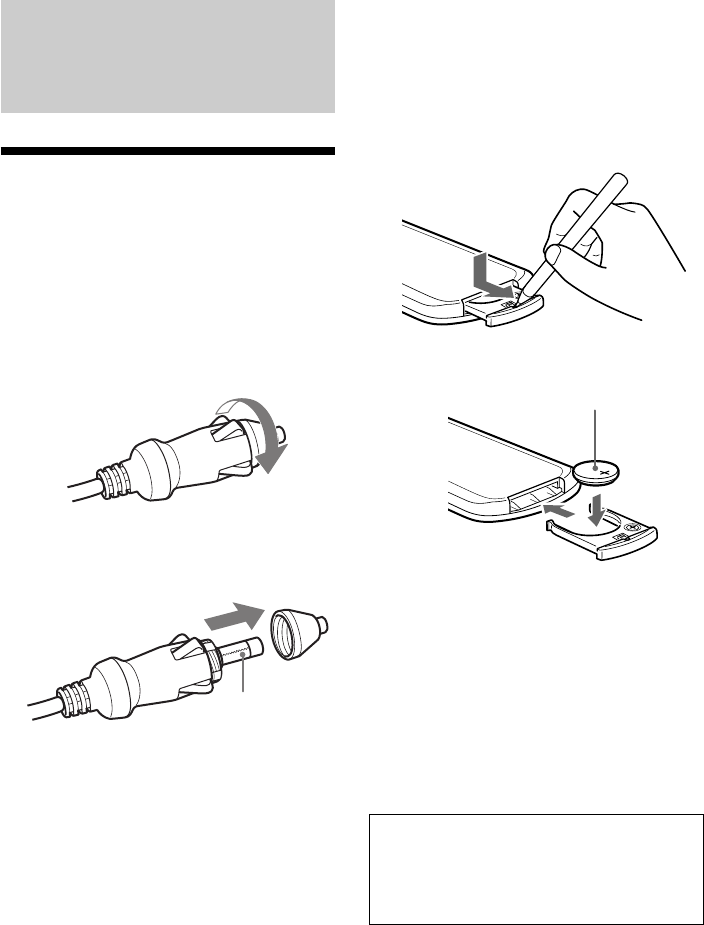
31
Additional
information
Maintenance
Fuse replacement
When replacing the fuse of the power cord for
the cigar lighter socket, be sure to use one
matching the amperage rating stated on the
original fuse. If the fuse blows, check the
power connection and replace the fuse. If the
fuse blows again after replacement, there may
be an internal malfunction. In such a case,
consult your nearest Sony dealer.
x
Warning
Never use a fuse with an amperage rating
exceeding the one supplied with the player as
this could damage the player.
Replacing the lithium battery of
the card remote commander
When the battery becomes weak, the range of
the card remote commander becomes shorter.
Replace the battery with a new CR2025 lithium
battery. Use of any other battery may present a
risk of fire or explosion.
x
Notes on lithium battery
•Keep the lithium battery out of the reach of
children. Should the battery be swallowed,
immediately consult a doctor.
•Wipe the battery with a dry cloth to assure
good contact.
•Be sure to observe the correct polarity when
installing the battery.
•Do not hold the battery with metallic
tweezers, otherwise a short-circuit may
occur.
WARNING
Battery may explode if mistreated.
Do not recharge, disassemble, or dispose of
in fire.
+ side up
Fuse
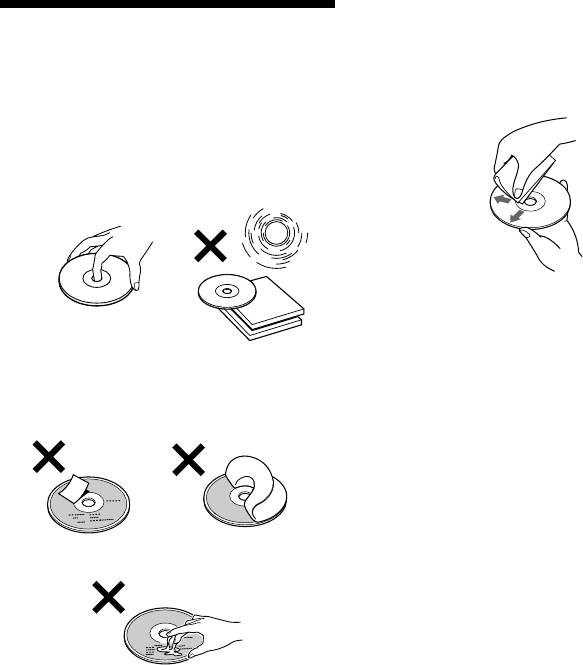
32
Notes on discs
•To keep the disc clean, do not touch the
surface. Handle the disc by its edge.
•Keep your discs in their cases or disc
magazines when not in use. Do not subject
the discs to heat/high temperature. Avoid
leaving them in parked cars or on
dashboards/rear trays.
•Do not attach labels, or use discs with sticky
ink/residue. Such discs may stop spinning
when used, causing a malfunction, or may
ruin the disc.
•Do not use any discs with labels or stickers
attached.
The following malfunctions may result from
using such discs:
— Inability to eject a disc (due to a label or
sticker peeling off and jamming the eject
mechanism).
— Inability to read audio data correctly (e.g.,
playback skipping, or no playback) due to
heat shrinking of a sticker or label causing
a disc to warp.
•Discs with non-standard shapes (e.g., heart,
square, star) cannot be played on this player.
Attempting to do so may damage the player.
Do not use such discs.
•Before playing, clean the discs with a
commercially available cleaning cloth. Wipe
each disc from the center out. Do not use
solvents such as benzine, thinner,
commercially available cleaners, or antistatic
spray intended for analog discs.
Music discs encoded with copyright
protection
This product is designed to play back discs
that conform to the Compact Disc (CD)
standard. Recently, various music discs
encoded with copyright protection are
marketed by some record companies. Please be
aware that among those discs, there are some
that do not conform to the CD standard and
may not be playable by this product.
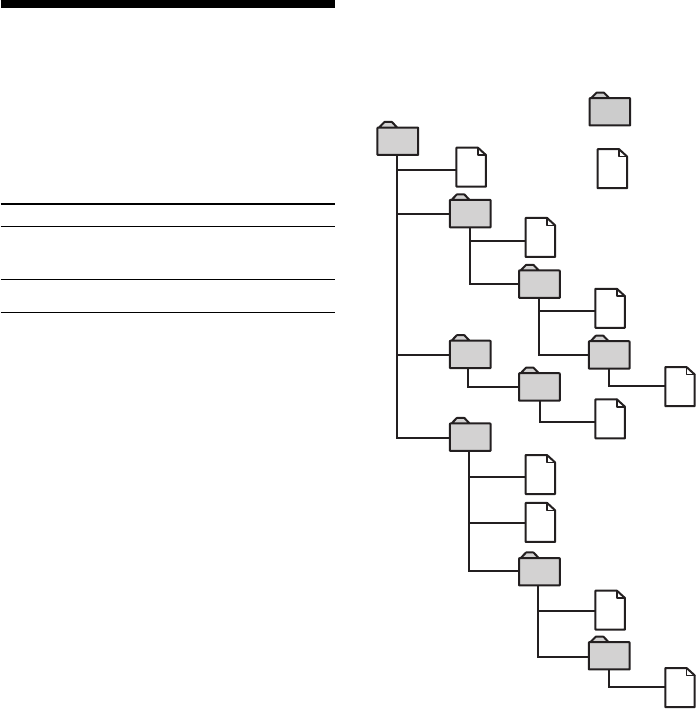
33
About MP3 files
MP3 (MPEG 1 Audio Layer-3) is a standard
technology and format for compressing a
sound sequence. The file is compressed to
about 1/10 of its original size. Sounds outside
the range of human hearing are compressed
while the sounds we can hear are not
compressed.
Recommended MP3 file format
Sampling frequency 32k, 44.1k, 48k
(Hz)
Bitrate (bps) 128k
Notes on discs
You can play MP3 files recorded on CD-ROMs,
CD-Rs, and CD-RWs.
The disc must be in the ISO 9660* level 1 or
level 2 format, or Joliet in the expansion
format.
* ISO 9660 Format
The most common international standard
for the logical format of files and folders on
a CD-ROM.
There are several specification levels. In
Level 1, file names must be in the 8.3 format
(no more than 8 characters in the name, no
more than 3 characters in the extension
“.MP3”) and in capital letters. Folder names
can be no longer than 8 characters. There can
be no more than 8 nested folder levels. Level
2 specifications allow file names up to 31
characters long.
Each folder can have up to 8 trees.
For Joliet in the expansion format, make sure
of the contents of the writing software, etc.
Notes
• With formats other than ISO 9660 level 1 and
level 2, folder names or file names may not be
displayed correctly.
• When naming, be sure to add the file extension
“.MP3” to the file name.
• If you put the extension “.MP3” to a file other
than MP3, the player cannot recognize the file
properly and will generate random noise that
could damage your speakers.
•The following discs take a longer time to start
playback.
—a disc recorded with complicated tree
structure.
—a disc to which data can be added.
•A high-bit rate MP3 file such as 320 kbps may not
play back properly.
The playback order of the MP3 files
The playback order of the folders and files is as
follows:
9
3
7
8
2
4
6
1
5
Tree 1 Tree 2 Tree 3 Tree 4 Tree 5
(root)
Tip
To specify a desired playback order, before the
folder or file name, input the order by number
(e.g., “01,” “02”), then record contents onto a disc
(The order differs depending on the writing
software).
Folder
(album)
MP3 file
(track)

34
Specifications
System
Laser Semiconductor laser
Signal format system NTSC/PAL
Audio characteristics
Frequency response 20 Hz to 20 kHz
Signal to noise ratio 90dB (A)
Harmonic distortion 0.03 %
Dynamic range 90dB
Wow and flutter below measurable limits
(±0.001% W PEAK)
General
Outputs Audio output
Video output
Optical output
Headphones output
Inputs Audio input
Video input
DC 12V input
Power requirements 12 V DC
Dimensions Approx. 188 × 99 × 241 mm
(7 1/2 × 4 × 9 1/2 in)
(w/h/d)
Mass Approx. 2.3 kg
(5 lb 1 oz)
Operating temperature 0 ˚C to 45 ˚C
(32 ˚F to 113 ˚F)
Supplied accessories Mounting straps (4)
AC power adaptor (1)
(including AC power cord
(1))
Power cord for the cigar
lighter socket (1)
Antenna for FM
transmission (1)
Card remote commander
RM-X137 (including
lithium battery (1))
Carrying bag (1)
Operating Instructions (1)
Monitor
System Liquid crystal color display
Display Manual flipdown panel
Drive system TFT-LCD active matrix
system
Picture size 6.5 inches wide screen
(16:9)
Picture segment 280,800 (w 1200 × h 234)
dots
Design and specifications are subject to change
without notice.
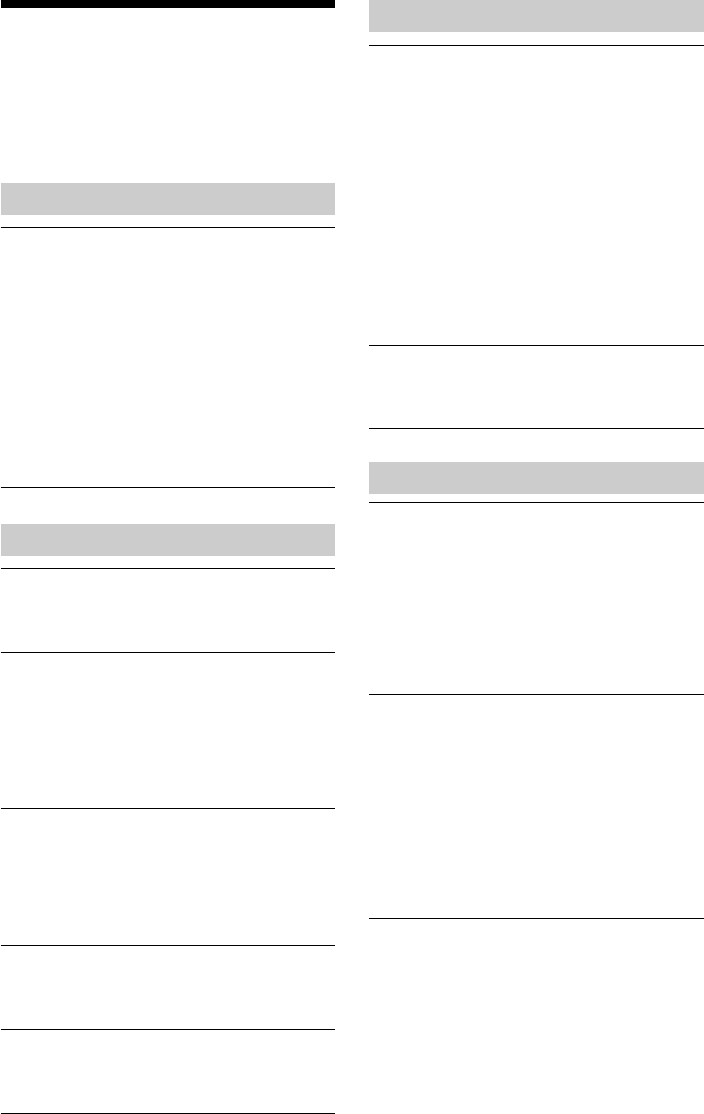
35
Troubleshooting
The following checklist will help you remedy
problems you may encounter with the player.
Before going through the checklist below,
check the connection and operating
procedures.
General
This player does not turn on.
•Check that the AC power adaptor or the
power cord for the cigar lighter socket is
connected correctly.
•If the power cord for the cigar lighter
socket is used, check the fuse.
tIf the fuse is blown, replace it with a
correctly rated fuse.
tIf the fuse blows again, consult your
nearest Sony dealer.
•The player may be overheated.
tMake sure that the player is turned off.
Wait until the player cools off, then
press (POWER) again.
Disc playback
A disc cannot be loaded.
•Another disc is already loaded.
•The disc is forcibly inserted upside down
or in the wrong way.
MP3 files cannot be played back.
•Recording was not performed according to
the ISO 9660 level 1 or level 2 format, or
the Joliet convention in the expansion
format.
•The file extension “.MP3” is not added to
the file name.
•Files are not stored in MP3 format.
MP3 files take longer to play back than
others.
The following discs take a longer time to
start playback.
—a disc recorded with a complicated tree
structure.
—a disc to which data can be added.
Playback functions such as pause are
deactivated.
•The RESET button has been pressed.
•The disc is ejected.
The sound skips.
•Dirty or defective disc.
•The player is installed in the place subject
to severe vibrations.
continue to next page t
Picture
There is no picture.
•Color system setting has been changed
manually while playing a DVD.
tChange the setting according to the
color system of the DVD, turn off the
player and turn it on again, or switch
the input channel to “VIDEO,” then
switch it to “DVD.”
•Check that the device connected to the
AUDIO/VIDEO INPUT connectors is
connected correctly.
•If there is no picture on the TV screen, etc.
connected to the player, check that the
device connected to the AUDIO/VIDEO
OUTPUT connectors is connected
correctly.
Picture noise appears.
•Dirty or defective disc.
•The player is installed in the place subject
to severe vibrations.
Operation
The card remote commander does not
function.
•Remove any obstacles between the card
remote commander and this player.
•Use the card remote commander closer to
the remote control sensor.
•Point the light emitter of the commander at
the remote control sensor of the player.
•Replace the battery in the remote if it is
weak.
The player does not play from the
beginning when playing a disc.
•Resume Playback may be activated.
tPress x again or eject the disc.
•Depending on the DVD, a title menu or a
DVD menu may automatically appear on
the monitor during playback.
tSelect the desired menu (page 18).
•Depending on the Video CD, the PBC
menu display automatically appears on the
monitor during playback.
tSelect the desired menu (page 20).
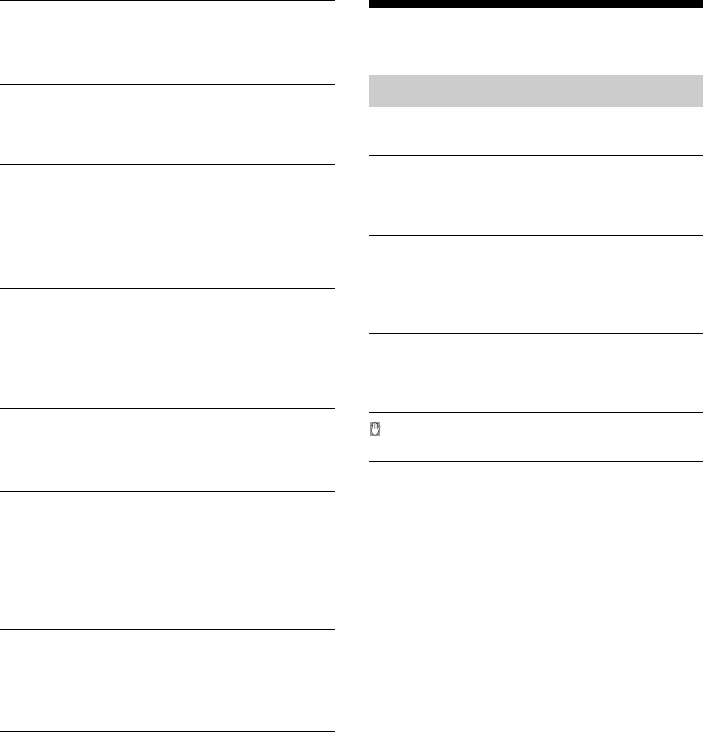
36
Playback stops automatically.
The disc may contain an auto pause signal.
While playing such a disc, this player stops
playback at the signal.
You cannot perform certain functions, such
as Stop or Search Playback.
With some discs, you cannot activate these
functions.
The language for the sound track cannot be
changed when you play a DVD.
• Multilingual tracks are not recorded on
the DVD.
• Changing the language for the track is
prohibited on the DVD.
The subtitle language cannot be changed
when you play a DVD.
•Multilingual subtitles are not recorded on
the DVD.
•Changing the language for the subtitles is
prohibited on the DVD.
The subtitles cannot be turned off when
you play a DVD.
Depending on the DVD, you may not be
able to turn the subtitles off.
The angles cannot be changed when you
play a DVD.
•Multi-angles are not recorded on the DVD.
•Change the angles at a scene recorded with
multiple angles (page 19).
•Changing the angles is prohibited on the
DVD.
This player does not operate properly.
Static electricity, etc., may affect this player’s
operation.
tTurn off the player, allow the player to
cool, then press (POWER) again.
Error display
Error displays
The following indications will be displayed for
about 8 seconds.
POWER OFF OVERHEAT
The player may be overheated.
tAllow the player to cool off, then press
(POWER) again.
REGION ERROR
The region code of the DVD currently in the
player does not conform to the player.
tMake sure the region code of the DVD
and the player (page 6).
DISC ERROR
•The data recorded on the disc is damaged.
•The player does not support the format in
which the data is recorded to the disc.
The operation cannot be done.

37
Language Code List
The language spellings conform to the ISO 639: 1988 (E/F) standard.
Code Language Code Language Code Language Code Language
6565 Afar 7089 Frisian 7771 Malagasy 8382 Serbian
6566 Abkhazian 7165 Irish 7773 Maori 8385 Sundanese
6570 Afrikaans 7168 Scots/Gaelic 7775 Macedonian 8386 Swedish
6577 Amharic 7176 Gallcian 7776 Malayalam 8387 Swahili
6582 Arabic 7178 Guarani 7778 Mongolian 8465 Tamil
6583 Assamese 7185 Gujarati 7779 Moldavian 8469 Tegule
6588 Aymara 7265 Hausa 7782 Marathi 8471 Tajik
6590 Azerbaijani 7273 Hindi 7783 Malay 8472 Thai
6665 Bashkir 7282 Croatian 7784 Maltese 8473 Tigrinya
6669 Byelorussian 7285 Hungarian 7789 Burmese 8475 Turkmen
6671 Bulgarian 7289 Armenian 7865 Nauru 8476 Tagalog
6672 Bislama 7365 Interlingua 7869 Nepali 8479 Tonga
6678 Bengali 7378 Indonesian 7876 Dutch 8482 Turkish
6679 Tibetan 7383 Icelandic 7879 Norwegian 8484 Tatar
6682 Breton 7384 Italian 7982 Oriya 8487 Twi
6765 Catalan 7387 Hebrew 8065 Punjabi 8575 Ukrainian
6779 Corsican 7465 Japanese 8076 Polish 8582 Urdu
6783 Czech 7473 Yiddish 8083 Pushto/Pashto 8590 Uzbek
6789 Welsh 7487 Javanese 8084 Portuguese 8673 Vietnamese
6865 Danish 7565 Georgian 8185 Quechua 8679 Volap_k
6869 German 7575 Kazakh 8277 Raeto-Romance 8779 Wolof
6890 Bhutani 7576 Greenlandic 8279 Romanian 8872 Xhosa
6976 Greek 7577 Cambodian 8285 Russian 8979 Yoruba
6978 English 7578 Kannada 8365 Kinyarwanda 9072 Chinese
6979 Esperanto 7579 Korean 8368 Sanskrit 9085 Zulu
6983 Spanish 7583 Kashmiri 8372 Serbo-Croatian
6984 Estonian 7585 Kurdish 8373 Sinhalese
6985 Basque 7589 Kirghiz 8375 Slovak
7065 Persian 7665 Latin 8376 Slovenian
7073 Finnish 7678 Lingala 8377 Samoan
7074 Fijian 7679 Laotian 8378 Shona
7079 Faroese 7684 Lithuanian 8379 Somali
7082 French 7686 Latvian Lettish 8381 Albanian

Sony Corporation Printed in Korea